Evidence for Nb-Ta Occurrences in the Syn-Tectonic Pan-African Mayo Salah Leucogranite (Northern Cameroon): Constraints from Nb-Ta Oxide Mineralogy, Geochemistry and U-Pb LA-ICP-MS Geochronology on Columbite and Monazite
Abstract
:1. Introduction
2. Geological Context
3. Analytical Methods
3.1. Whole-Rock Geochemistry
3.2. Imaging and Mineral Chemistry
3.3. U-Pb Dating of Columbite and Monazite using Laser Ablation-Inductively Coupled Plasma-Mass Spectrometry (LA-ICP-MS)
4. Results
4.1. The Mayo Salah Pluton: Field Relationships, Structural Constraints and Macroscopic Petrographic Features
4.1.1. Field Relationships and Macroscopic Features
- (i)
- Porphyric medium- to coarse-grained muscovite leucogranite (MsLC) is the dominant leucogranite subgroup and it represents most of the northern part of the pluton (Figure 3), and it displays progressive contact with the MsG and MsLCm in its southern limit (see below in the text). The outcrops are generally highly fractured blocks and flagstones (Figure 4d). The rock is leucocratic medium- to coarse-grained made of quartz, plagioclase, muscovite, ±Nb-Ta oxides, and ±garnet (Figure 4e,f). At the transition with the MsLCm facies, the MsLC facies displays an abundant and disseminated concentration of Mn-oxide minerals and miarolitic cavities that are rounded by Mn-oxide.
- (ii)
- Porphyric medium- to coarse-grained muscovite leucogranite, Mn-oxide-bearing (MsLCm), is much observed on the highest hill in the southeast sector of the pluton (Figure 3). It displays a sharp contact with the MsLC. The major difference with the MsLC is its mesocratic color index, due to the high proportion of the disseminated flecks of Mn-oxide (Figure 4g–i).
- (iii)
- Microgranular fine-grained muscovite leucogranite (MsLF) (<1/5 of the pluton) consists of many pockets of ≤10 m of outcrops (Figure 4j), which are usually at the borders of other leucogranites or are in contact with the host rock. It is leucocratic (Figure 4k) and fine-grained made of quartz, feldspar, and muscovite, with a preferred orientation of muscovite (Figure 4l). The texture is microgranular or aplitic at the contacts with the host rock or with the pegmatite.
- (iv)
- Pegmatites (Peg) outcrops as large veins that are discontinuously distributed in the Ms-leucogranite and crosscut the intruded schists, they also contain xenoliths of schists (Figure 4m and Figure 5f). It varies in thickness from <1 to ca. 15 m and average 30 m in length. It is characterized by quartz, feldspar, and K-feldspar megacrysts, with flakes of muscovite, plagioclase and Nb-Ta-oxide in interstice (Figure 4n,o). Accessory Mn-oxide occurs in fractures and in cleavage cracks.
4.1.2. Structural Features
4.2. Mineralogical Assemblages of the Main Facies
4.3. Habit, Distribution, Texture and Compositions of Rare-Element-Bearing Minerals
4.3.1. Columbite-Group Mineral
4.3.2. Other Ta-Nb Oxide Minerals (TNO)
4.4. Whole-Rock Geochemistry of Mayo Salah Pluton (MSP)
4.4.1. Major Element Characteristics
4.4.2. Trace Element and REE Patterns
4.4.3. Trace Element Features
4.5. U-Pb Dating of Columbite and Monazite
4.5.1. The Coarse-Grained Muscovite Leucogranite (MsLC, Sample MS35c)
4.5.2. The Coarse-Grained Muscovite Leucogranite, Mn-Oxide-Bearing (MsLCm, Sample MS38)
5. Discussion
5.1. The Mayo Salah Pluton: A Peraluminous Low-Phosphorous Rare-Metal Granite
5.2. Geotectonic Setting of the Mayo Salah Pluton: Significance in the Northern Cameroon Domain (NCD) of the Central Africa Fold Belt (CAFB)
5.3. Comparison with Pan-African Rare-Metal Granite and Pegmatite
6. Conclusions
- (1)
- The Mayo Salah pluton shares the features of rare-metal granites RMG with local occurrences of rare-element minerals during the magmatic fractionation of this pluton. Rare-element mineralization (Nb, Ta, and Sn) is expressed as cassiterite and homogeneously disseminated Nb-Ta oxides, such as coltan, rutile, and pyrochlore. The Nb-Ta oxides are classified as Mn-columbite and are magmatic in origin. The progressive zonation of these minerals suggest a magmatic fractionation with earlier Nb-rich Mn-columbite and late Ta-rich Mn columbite. The later stage might be related to magmato-hydrothermal alteration. The rare-element leucogranite of the Mayo Salah pluton is peraluminous and I-type to S-type suggesting an origin from melting of crustal material with a contribution of sediments. The leucogranite of Mayo Salah is classified into the peraluminous low-phosphorus group of RMG.
- (2)
- The LA-ICP-MS U-Pb dating of columbite and monazite yields ages between 603.2 ± 5.3 and 581.6 ± 7.2 Ma, which provide evidence for the genesis of the Nb-Ta occurrences of the Mayo Salah pluton by a late-Neoproterozoic (Pan-African) magmatic event. Structural and geochronological features show that the MSP is related to the late D2 to syn-tectonic D3 events that were recorded in the CAFB. The Nb-Ta occurrences of the Mayo Salah pluton can be related to the Pan-African Nb-Ta epoch proposed by [45] ranging from ca. 600 to 450 Ma (late-Neoproterozoic to early-Paleozoic) and that includes Pan-African belts surrounding the Congo Craton as the Central Africa Fold Belt, Mozambique Belt, Damara Belt in Namibia, and the northern part of the East African Orogenic Belt.
Supplementary Materials
Author Contributions
Acknowledgments
Conflicts of Interest
References
- Chakhmouradian, A.R. High-field-strength elements in carbonatitic rocks: Geochemistry, crystal chemistry and significance for constraining the sources of carbonatites. Chem. Geol. 2006, 235, 138–160. [Google Scholar] [CrossRef]
- Linnen, R.L.; Van Lichtervelde, M.; Černý, P. Granitic pegmatites: Granitic pegmatites as sources of strategic metals. Elements 2012, 8, 275–280. [Google Scholar] [CrossRef]
- Linnen, R.L.; Samson, I.M.; Williams-Jones, A.E.; Chakhmouradian, A.R. Geochemistry of the rare-earth element, Nb, Ta, Hf, and Zr deposits. In Treatise on Geochemistry, 2nd ed.; Heinrich, D.H., Andrew, M.D., Eds.; Elsevier Science: New York, NY, USA, 2014; Volume 13, pp. 543–568. [Google Scholar]
- Linnen, R.L.; Cuney, M. Granite-related rare-element deposits and experimental constraints on Ta-Nb-W-Sn-Zr-Hf mineralization. In Rare-Element Geochemistry and Mineral Deposits; Linnen, R.L., Samson, I.M., Eds.; Short Course Notes; Geological Association of Canada: St. John’s, NL, Canada, 2005; Volume 17, pp. 45–68. [Google Scholar]
- Dostal, J. Rare earth element deposits of alkaline igneous rocks. Resources 2017, 6, 34. [Google Scholar] [CrossRef]
- Cuney, M.; Marignac, C.; Weisbrod, A. The Beauvoir topaz–lepidolite albite granite (Massif Central, France); the disseminated magmatic Sn-Li-Ta-Nb-Be mineralization. Econ. Geol. 1992, 87, 1766–1794. [Google Scholar] [CrossRef]
- Fouillac, A.M.; Rossi, P. Near-solidus δ18 O depletion in a Ta-Nb-bearing albite granite: The Beauvoir granite, France. Econ. Geol. 1991, 86, 1704–1720. [Google Scholar] [CrossRef]
- Wang, R.C.; Fontan, F.; Monchoux, P. Minéraux disséminés comme indicateurs du caractère pegmatitique du granite de Beauvoir, Massif d’Echassières, allier, France. Can. Mineral. 1992, 30, 763–770. [Google Scholar]
- Belkasmi, M.; Cuney, M.; Pollard, P.J.; Bastoul, A. Chemistry of the Ta-Nb-Sn-W oxide minerals from the Yichun rare metal granite (SE China): Genetic implications and comparison with Moroccan and French Hercynian examples. Mineral. Mag. 2000, 64, 507–523. [Google Scholar] [CrossRef]
- Huang, X.L.; Wang, R.C.; Chen, X.M.; Hu, H.; Liu, C.S. Vertical variations in the mineralogy of the Yichun topaz–lepidolite granite, Jiangxi Province, southern China. Can. Mineral. 2002, 40, 1047–1068. [Google Scholar] [CrossRef]
- Breiter, K.; Škoda, R.; Uher, P. Nb–Ta–Ti–W–Sn–oxide minerals as indicators of a peraluminous P- and F-rich granitic system evolution: Podlesí, Czech Republic. Mineral. Petrol. 2007, 91, 225–248. [Google Scholar] [CrossRef]
- René, M.; Škoda, R. Nb-Ta-Ti oxides fractionation in rare-metal granites: Krásno-Horní Slavkov ore district, Czech Republic. Mineral. Petrol. 2011, 103, 37–48. [Google Scholar] [CrossRef]
- Rao, C.; Wang, R.C.; Hu, H.; Zhang, W.L. Complex internal textures in oxide minerals from the Nanping No. 31 dyke of granitic pegmatite, Fujian province, southeastern China. Can. Mineral. 2009, 47, 1195–1212. [Google Scholar] [CrossRef]
- Xie, L.; Wang, R.C.; Che, X.D.; Huang, F.F.; Erdmann, S.; Zhang, W.-L. Tracking magmatic and hydrothermal Nb–Ta–W–Sn fractionation using mineral textures and composition: A case study from the late Cretaceous Jiepailing ore district in the Nanling Range in South China. Ore Geol. Rev. 2016, 78, 300–321. [Google Scholar] [CrossRef]
- Zhu, Z.Y.; Wang, R.C.; Che, X.D.; Zhu, J.C.; Wei, X.L.; Huang, X.E. Magmatic–hydrothermal rare-element mineralization in the Songshugang granite (northeastern Jiangxi, China): Insights from an electron-microprobe study of Nb–Ta–Zr minerals. Ore Geol. Rev. 2015, 65, 749–760. [Google Scholar] [CrossRef]
- Kovalenko, V.I. The genesis of rare metal granitoids and related ore deposits. In Metallization Associated with Acid Magmatism; Štemprok, M.B., Tischendorf, G., Eds.; Geological Survey: Prague, Czech Republic, 1978; Volume 3, pp. 235–258. [Google Scholar]
- Eby, G.N. Chemical subdivision of the A type granitoids: Petrogenetic and tectonic implications. Geology 1992, 20, 641–644. [Google Scholar] [CrossRef]
- Ishihara, S. The granitoids series and mineralization. Econ. Geol. 1981, 75, 458–484. [Google Scholar]
- White, A.J.R.; Chappell, B.W. Ultrametamorphism and granite genesis. Tectonophysics 1977, 43, 7–22. [Google Scholar] [CrossRef]
- Černý, P.; Ercit, T.S. Some recent advances in the mineralogy and geochemistry of Nb and Ta in rare-element granitic pegmatites. Bull. Minerai 1985, 108, 499–532. [Google Scholar]
- Turlin, F.; André-Mayer, A.-S.; Moukhsil, A.; Vanderhaeghe, O.; Gervais, F.; Solgadi, F.; Groulier, P.-A.; Poujol, M. Unusual LREE-rich, peraluminous, monazite- or allanite-bearing pegmatitic granite in the central Grenville Province, Québec. Ore Geol. Rev. 2017, 89, 627–667. [Google Scholar] [CrossRef]
- Ballouard, C.; Poujol, M.; Boulvais, P.; Branquet, Y.; Tartèse, R.; Vigneresse, J.-L. Nb-Ta fractionation in peraluminous granites: A marker of the magmatic-hydrothermal transition. Geology 2016, 44, 231–234. [Google Scholar] [CrossRef]
- Černý, P. Petrogenesis of granitic pegmatites. In Granitic Pegmatites in Science and Industry; Černý, P., Ed.; Short Course Handbook; Mineralogical Association of Canada: Québec City, QC, Canada, 1982; Volume 8, pp. 405–461. [Google Scholar]
- Černý, P.; Ercit, T.S. Mineralogy of niobium and tantalum: Crystal chemical relationships, paragenetic aspects and their economic implications. In Lanthanides, Tantalum and Niobium; Möller, P., Černý, P., Saupé, F., Eds.; Springer Verlag: Berlin Heidelberg, Germany, 1989; pp. 27–79. [Google Scholar]
- Černý, P.; Blevin, P.L.; Cuney, M.; London, D. Granite-related ore deposits. Econ. Geol. 2005, 100, 337–370. [Google Scholar]
- Ercit, T.S. REE-enriched granitic pegmatites. In Rare-Element Geochemistry and Mineral Deposits; Linnen, R.L., Samson, I.M., Eds.; Short Course Notes; Geological Association of Canada: St. John’s, NL, Canada, 2005; Volume 17, pp. 175–199. [Google Scholar]
- Tadesse, S.; Zerihun, D. Composition, fractionation trend and zoning accretion of the columbite–tantalite group of minerals in the Kenticha rare metal field (Adola, southern Ethiopia). J. Afr. Earth Sci. 1996, 23, 411–431. [Google Scholar] [CrossRef]
- Van Lichtervelde, M.; Salvi, S.; Beziat, D.; Linnen, R.L. Textural features and chemical evolution in tantalum oxides; magmatic versus hydrothermal origins for Ta mineralization in the Tanco lower pegmatite, Manitoba, Canada. Econ. Geol. 2007, 102, 257–276. [Google Scholar] [CrossRef]
- Van Lichtervelde, M.; Holtz, F.; Hanchar, J.M. Solubility of manganotantalite, zircon and hafnon in highly fluxed peralkaline to peraluminous pegmatitic melts. Contrib. Mineral. Petrol. 2010, 160, 17–32. [Google Scholar] [CrossRef]
- Breiter, K.; Škoda, R. Vertical zonality of fractionated granite plutons refected in zircon chemistry: The Cínovec A-type versus the Beauvoir S-type suite. Geol. Carpath. 2012, 63, 383–398. [Google Scholar] [CrossRef]
- Černý, P.; Goad, B.E.; Hawthorne, F.C.; Chapman, R. Fractionation trends of the Nb and Ta-bearing oxide minerals in the Greer Lake pegmatitic granite and its pegmatite aureole, southeastern Manitoba. Am. Mineral. 1986, 71, 501–517. [Google Scholar]
- Harlaux, M.; Marignac, C.; Cuney, M.; Mercadier, J.; Magott, R.; Mouthier, B. Nb-Ti-Y-HREE-W-U oxide minerals with uncommon compositions associated with the tungsten mineralization in the Puy-les-Vignes deposit (Massif central, France): Evidence for rare-metal mobilization by late hydrothermal fluids with a peralkaline signature. Can. Mineral. 2015, 53, 653–672. [Google Scholar] [CrossRef]
- Harlaux, M.; Romer, R.L.; Mercadier, J.; Morlot, C.; Marignac, C.; Cuney, M. 40 Ma of hydrothermal W mineralization during the Variscan orogenic evolution of the French Massif Central revealed by U-Pb dating of wolframite. Miner. Depos. 2017, 53, 21–51. [Google Scholar] [CrossRef]
- Lerouge, C.; Gloaguen, W.G.; Bailly, L. Distribution of In and other rare metals in cassiterite and associated minerals in Sn, W ore deposits of the western Variscan Belt. Eur. J. Mineral. 2017, 29, 739–753. [Google Scholar] [CrossRef]
- Wang, R.C.; Hu, H.; Zhang, A.C. Pollucite and the cesium-dominant analogue of polylithionite as expressions of extreme Cs enrichment in the Yichun topaz-lepidolithe granite, Southern China. Can. Mineral. 2004, 42, 883–896. [Google Scholar] [CrossRef]
- Linnen, R.L. The solubility of Nb-Ta-Zr-Hf-Win granitic melts with Li and Li + F: Constraints for mineralization in rare metal granites and pegmatites. Econ. Geol. 1998, 93, 1013–1025. [Google Scholar] [CrossRef]
- Linnen, R.L.; Keppler, H. Columbite solubility in granitic melts; consequences for the enrichment and fractionation of Nb and Ta in the Earth’s crust. Contrib. Mineral. Petrol. 1997, 128, 213–227. [Google Scholar] [CrossRef]
- Tiepolo, M.; Bottazzi, P.; Foley, S.F.; Oberti, R.; Vannucci, R.; Zanetti, A. Fractionation of Nb and Ta from Zr and Hf at mantle depths: The role of titanian pargasite and kaersutite. J. Petrol. 2001, 42, 221–232. [Google Scholar] [CrossRef]
- Salvi, S.; Williams-Jones, A.E. Alkaline granite-syenite hosted deposits. In Rare Element Geochemistry and Mineral Deposits; Linnen, R.L., Samson, I.M., Eds.; Short Course Notes; Geological Association of Canada: St. John’s, NL, Canada, 2005; Volume 17, pp. 315–341. [Google Scholar]
- Dill, H.G. Pegmatite and aplites: Their genetic and applied ore geology. Ore Geol. Rev. 2015, 65, 417–561. [Google Scholar] [CrossRef]
- Aseri, A.A.; Linnen, R.L.; Che, X.D.; Yves, T.; Francois, H. Effects of fluorine on the solubilities of Nb, Ta, Zr and Hf minerals in highly fluxed water-saturated haplogranitic melts. Ore Geol. Rev. 2015, 64, 736–746. [Google Scholar] [CrossRef]
- Fiege, A.; Kirchner, C.; Holtz, F.; Linnen, R.L.; Dziony, W. Influence of fluorine on the solubility of manganotantalite (MnTa2O6) and manganocolumbite (MnNb2O6) in granitic melts—An experimental study. Lithos 2011, 122, 165–174. [Google Scholar] [CrossRef]
- Keppler, H. Influence of fluorine on the enrichment of high field strength trace elements in granitic rocks. Contrib. Mineral. Petrol. 1993, 114, 479–488. [Google Scholar] [CrossRef]
- Deschamps, Y.; Hocquard, C.; Pelon, R.; Milési, J.P.; Ralay, F. Geology and Ta Ore Deposits (Africa); BRGM: Orléans, France, 2006; Map 1:10,000,000.
- Melcher, F.; Graupner, T.; Gäbler, H.-E.; Sitnikova, M.; Henjes-Kunst, F.; Oberthür, T.; Gerdes, A.; Dewaele, S. Tantalum-(niobium-tin) mineralisation in African pegmatites and rare metal granites: Constraints from Ta-Nb oxide mineralogy, geochemistry and U-Pb geochronology. Ore Geol. Rev. 2015, 64, 667–719. [Google Scholar] [CrossRef]
- Akoh, J.U.; Ogunleye, P.O.; Ibrahim, A.A. Geochemical evolution of micas and Sn-, Nb-, Ta-mineralization associated with the rare metal pegmatite in Angwan Doka, central Nigeria. J. Afr. Earth Sci. 2015, 112, 24–36. [Google Scholar] [CrossRef]
- Dewaele, S.; De Clerq, F.; Muchez, P.; Schneider, J.; Burgess, R.; Boyce, A.; Fernandez-Alonso, M. Geology of the cassiterite mineralisation in the Rutongo area, Rwanda (Central Africa): Current state of knowledge. Geol. Belgica 2010, 13, 91–112. [Google Scholar]
- Dewaele, S.; Henjes-Kunst, F.; Melcher, F.; Sitnikova, M.; Burgess, R.; Gerdes, A.; Fernandez-Alonso, M.; De Clerq, F.; Muchez, P.; Lehmann, B. Late Neoproterozoic overprinting of the cassiterite and columbite–tantalite bearing pegmatites of the Gatumba area, Rwanda (Central Africa). J. Afr. Earth Sci. 2011, 61, 10–26. [Google Scholar] [CrossRef]
- Dewaele, S.; Hulsbosch, N.; Cryns, Y.; Boyce, A.; Burgess, R.; Muchez, P. Geological setting and timing of the world-class Sn, Nb–Ta and Li mineralization of Manono-Kitotolo (Katanga, Democratic Republic of Congo). Ore Geol. Rev. 2015, 72, 373–390. [Google Scholar] [CrossRef]
- Diehl, M. Rare metal pegmatites of the Cape Cross-Uis pegmatite belt, Namibia: Geology, mineralisation, rubidium-strontium characteristics and petrogenesis. J. Afr. Earth Sci. 1993, 17, 167–181. [Google Scholar] [CrossRef]
- Hulsbosch, N.; Hertogen, J.; Dewaele, S.; Andre, L.; Muchez, P. Petrographic and mineralogical characterisation of fractionated pegmatites culminating in the Nb-Ta-Sn pegmatites of the Gatumba area (western Rwanda). Geol. Belgica 2013, 16, 105–117. [Google Scholar]
- Küster, D. Rare-metal pegmatites of Wamba, central Nigeria—Their formation in relationship to late Pan-African granites. Miner. Depos. 1990, 25, 25–33. [Google Scholar] [CrossRef]
- Küster, D. Granitoid-hosted Ta mineralization in the Arabian–Nubian Shield: Ore deposit types, tectono-metallogenetic setting and petrogenetic framework. Ore Geol. Rev. 2009, 35, 68–86. [Google Scholar] [CrossRef]
- Milési, P.; Toteu, S.F.; Deschamps, Y.; Feybesse, J.L.; Lerouge, C.; Cocherie, A.; Penaye, J.; Tchameni, R.; Moloto-A-Kenguemba, G.; Kampubzu, H.A.B.; et al. An overview of the geology and major ore deposits of Central Africa: Explanatory note for the 1:4,000,000 map “Geology and major ore deposits of Central Africa”. J. Afr. Earth Sci. 2006, 44, 571–595. [Google Scholar] [CrossRef]
- Ogunleye, P.O.; Garba, I.; Ike, E.C. Factors contributing to enrichment and crystallization of niobium in pyrochlore in the Kaffo albite arfvedsonite granite, Ririwai Complex, Younger Granites province of Nigeria. J. Afr. Earth Sci. 2006, 44, 372–382. [Google Scholar] [CrossRef]
- Pohl, W. Metallogeny of the northeastern Kibara belt, Central Africa—Recent perspectives. Miner. Depos. 1994, 9, 105–130. [Google Scholar] [CrossRef]
- Decrée, S.; Boulvais, P.; Cobert, C.; Baele, J.M.; Midende, G.; Gardien, V.; Tack, L. Structurally-controlled hydrothermal alteration in the syntectonic Neoproterozoic Upper Ruvubu Alkaline Plutonic Complex (Burundi): Implications for REE and HFSE. Precambrian Res. 2015, 269, 281–295. [Google Scholar] [CrossRef] [Green Version]
- De Wit, M.J.; Stankiewicz, J.; Reeves, C. Restoring Pan-African-Brasiliano Connections: More Gondwana Control, Less Trans-Atlantic Corruption; The Geological Society London: London, UK, 2008; Volume 294, pp. 399–412. [Google Scholar] [CrossRef]
- Allen, P.A. The Huqf Supergroup of Oman: Basin development and context for Neoproterozoic glaciation. Earth-Sci. Rev. 2007, 84, 139–185. [Google Scholar] [CrossRef]
- Kröner, A.; Stern, R.J. Africa: Pan-African orogeny. In Encyclopedia of Geology; Elsevier: Amsterdam, The Netherlands, 2004; Volume 1, pp. 1–12. [Google Scholar]
- Bouyo Houketchang, M.; Penaye, J.; Barbey, P.; Toteu, S.F.; Wandji, P. Petrology of high-pressure granulite facies metapelites and metabasites from Tchollirée and Banyo regions: Geodynamic implication for the Central African Fold Belt (CAFB) of north-central Cameroon. Precambrian Res. 2013, 224, 412–433. [Google Scholar] [CrossRef]
- Bouyo Houketchang, M.; Zhao, Y.; Penaye, J.; Zhang, S.H.; Njel, U.O. Neoproterozoic subduction-related metavolcanic and metasedimentary rocks from the Rey Bouba Greenstone Belt of north-central Cameroon in the Central African Fold Belt: New insights into a continental arc geodynamic setting. Precambrian Res. 2015, 261, 40–53. [Google Scholar] [CrossRef]
- Bouyo Houketchang, M.; Penaye, J.; Njel, U.O.; Moussango, A.P.I.; Sep, J.P.N.; Nyama, B.A.; Wassouo, W.J.; Abate, J.M.E.; Yaya, F.; Mahamat, A.; et al. Geochronological, geochemical and mineralogical constraints of emplacement depth of TTG suite from the Sinassi Batholith in the Central African Fold Belt (CAFB) of northern Cameroon: Implications for tectonomagmatic evolution. J. Afr. Earth Sci. 2016, 116, 9–41. [Google Scholar] [CrossRef]
- Ngako, V.; Affaton, P.; Njonfang, E. Pan-African tectonics in northwestern Cameroon: Implication for the history of western Gondwana. Gondwana Res. 2008, 14, 509–522. [Google Scholar] [CrossRef]
- Negue, N.E.; Tchameni, R.; Vanderhaeghe, O.; Barbey, P.; Tchunte, P.M.F.; Takodjou, W.J.D.; Lemdjou, B.Y.; Saha, F.A.N. Petrography and geochemistry of the Mbip Granitic Massif, SW Tchollirée (Central North Cameroon): Petrogenetic and geodynamic implication. Int. J. Geosci. 2015, 6, 761–775. [Google Scholar] [CrossRef]
- Negue, N.E.; Tchameni, R.; Vanderhaeghe, O.; Fenguye, S.; Barbey, P.; Tekoum, L.; Eglinger, A.; Fosso Tchunte, P.M.; Saha, F.A.N. Structure and LA-ICP-MS zircon U-Pb dating of syntectonic plutons emplaced in the Pan-African Banyo-Tcholliré shear zone (central north Cameroon). J. Afr. Earth Sci. 2017, 131, 251–271. [Google Scholar]
- Penaye, J.; Kröner, A.; Toteu, S.F.; Van Schmus, W.R.; Doumnang, J.-C. Evolution of the Mayo Kebbi region as revealed by zircon dating: An early (ca. 740 Ma) Pan-African magmatic arc in southwestern Chad. J. Afr. Earth Sci. 2006, 44, 530–542. [Google Scholar] [CrossRef]
- Toteu, S.F.; Van Schmus, R.W.; Penaye, J.; Michard, A. New U-Pb and Sm-Nd data from north-central Cameroon and its bearing on the pre-Pan-African history of central Africa. Precambrian Res. 2001, 108, 45–73. [Google Scholar] [CrossRef]
- Toteu, S.F.; Penaye, J.; Poudjom Djomani, Y. Geodynamic evolution of the Pan-African belt in central Africa with special reference to Cameroon. Can. J. Earth Sci. 2004, 41, 73–85. [Google Scholar] [CrossRef]
- Toteu, S.F.; Penaye, J.; Deloule, E.; Van Schmus, W.R.; Tchameni, R. Diachronous evolution of volcano-sedimentary basins north of the Congo craton: Insights from U-Pb ion microprobe dating of zircons from the Poli, Lom and Yaoundé groups (Cameroon). J. Afr. Earth Sci. 2006a, 44, 428–442. [Google Scholar] [CrossRef]
- Le Fur, Y. Section 2: Géologie Appliquée, chronique des mines. In Les Indices de cuivre du Groupe Volcano-Sédimentaire de Poli (Cameroun); Bureau de Recherches Géologiques et Minières: Orléans, France, 1971; Volume 6, p. 79. [Google Scholar]
- Isseini, M.; André-Mayer, A.S.; Vanderhaeghe, O.; Barbey, P.; Deloule, E. A-type granites from the Pan-African orogenic belt in south-western Chad constrained using geochemistry, Sr-Nd isotopes and U-Pb geochronology. Lithos 2012, 153, 39–52. [Google Scholar] [CrossRef]
- Kouske, A.P.; Suh, C.E.; Ghogomu, R.T.; Ngako, V. Na-Metasomatism and Uranium Mineralization during a Two-Stage Albitization at Kitongo, Northern Cameroon: Structural and Geochemical Evidence. Int. J. Geosci. 2012, 3, 258–279. [Google Scholar] [CrossRef]
- Kusnir, I. Géologie, Ressources Minérales et Ressources en eau du Tchad, 2nd ed.; CNAR: Ndjaména, Chad, 1995; p. 116. [Google Scholar]
- Mbaguedje, D. Métallogénie de l’or et de L’uranium dans le Cadre de la Croissance et de la Différenciation de la Croûte au Néoprotérozoïque: Exemple du Massif du Mayo-Kebbi (Tchad) dans la Ceinture Orogénique d’Afrique Centrale. Ph.D. Thesis, Université de Lorraine, GeoRessources-CREGU, Lorraine, France, 2015. [Google Scholar]
- Oesterlen, M.; Vetter, U. Petrographic-Geochemical Characteristics and Genesis of an Albitized Uraniferous Granite in Northern Cameroon, Africa. Vein Type Uranium Deposits; Technical Document; International Atomic Energy Agency: Vienna, Austria, 1986; Volume 361, pp. 113–142. [Google Scholar]
- Pinna, P.; Edimo, A.; Jézéquel, J.; Tchountchoui, D.; Ebotayuk-Ebop, M. Inventaire Minier du Centre-Nord Cameroun (Troisième Phase); Open-File Report 88 CMR 168; BRGM: Orléans, France, 1989.
- Vels, B.; Fritsche, R. Sodium metasomatism in the Kitongo uranium occurrence near Poli, Cameroon. Uranium 1988, 4, 365–383. [Google Scholar]
- Toteu, S.F. Geochemical characterization of the main petrographical and structural units of northern Cameroon: Implications for Pan-African evolution. J. Afr. Earth Sci. 1990, 10, 615–624. [Google Scholar] [CrossRef]
- Abdelsalam, M.G.; Liégeois, J.P.; Stern, R.J. The Saharan metacraton. J. Afr. Earth Sci. 2002, 34, 119–136. [Google Scholar] [CrossRef]
- Abdelsalam, M.G.; Gao, S.S.; Liégeois, J.-P. Upper mantle structure of the Saharan Metacraton. J. Afr. Earth Sci. 2011, 60, 328–336. [Google Scholar] [CrossRef]
- Bouyo Houketchang, M.; Toteu, S.F.; Deloule, E.; Penaye, J.; Van Schmus, W.R. U-Pb and Sm-Nd dating of high-pressure granulites from Tchollirée and Banyo regions: Evidence for a Pan-African granulite facies metamorphism in northcentral Cameroon. J. Afr. Earth Sci. 2009, 54, 144–154. [Google Scholar] [CrossRef]
- Dawaï, D.; Bouchez, J.-L.; Paquette, J.-L.; Tchameni, R. The Pan-African quartz-syenite of guider (north-Cameroon): Magnetic fabric and U-Pb dating of a late orogenic emplacement. Precambrian Res. 2013, 236, 132–144. [Google Scholar] [CrossRef]
- Tchameni, R.; Sun, F.; Dawaï, D.; Danra, G.; Tékoum, L.; Negue, N.E.; Vanderhaeghe, O.; Nzolang, C.; Dagwaï, N. Zircon dating and mineralogy of the Mokong Pan-African magmatic epidote-bearing granite (North Cameroon). Int. J. Earth Sci. 2016, 105, 1811–1830. [Google Scholar] [CrossRef]
- Ganwa, A.A.; Frisch, W.; Siebel, W.; Ekodeck, G.E.; Kongnyuy, C.; Ngako, V. Archean inheritances in the pyroxene-amphibole-bearing gneiss of the Méiganga area (Central North Cameroon): Geochemical and 207Pb/206Pb age imprints. C.R. Geosci. 2008, 340, 211–222. [Google Scholar] [CrossRef]
- Ganwa, A.A.; Klötzli, S.U.; Hauzenberger, C. Evidence for Archean inheritance in the pre-Panafrican crust of Central Cameroon: Insight from zircon internal structure and LA-MC-ICP-MS U-Pb ages. J. Afr. Earth Sci. 2016, 120, 12–22. [Google Scholar] [CrossRef]
- Penaye, J.; Toteu, S.F.; Tchameni, R.; Van Schmus, W.R.; Tchakounte, J.; Ganwa, A.A.; Minyem, D.; Nsifa, E.N. The 2.1 Ga West Central African belt in Cameroon: Extension and evolution. J. Afr. Earth Sci. 2004, 39, 159–164. [Google Scholar] [CrossRef]
- Doumnang, J.-C. Géologie des Formations Néoprotérozoïques du Mayo Kebbi (Sud-Ouest du Tchad): Apports de la Pétrologie et de la Géochimie, Implications sur la Géodynamique au Panafricain. Ph.D. Thesis, Université d’Orléans, Orléans, France, 2006. [Google Scholar]
- Ngako, V.; Jégouzo, P.; Soba, D. Déformation et métamorphisme dans la chaîne panafricaine de Poli (Nord Cameroun): Implications géodynamiques et paléogéographiques. J. Afr. Earth Sci. 1989, 9, 541–555. [Google Scholar] [CrossRef]
- Njel, U.O. Paléogéographie d’un segment de l’orogenèse panafricaine: La ceinture volcano-sédimentaire de Poli (Nord Cameroun). C.R. Acad. Sci. Paris 1986, 303, 1737–1742. [Google Scholar]
- Pinna, P.; Calvez, J.-Y.; Abessolo, A.; Angel, J.-M.; Mekoulou-Mekoulou, T.; Mananga, G.; Vernhet, Y. Neoproterozoic events in the Tcholliré area: Pan-African crustal growth and geodynamics in central-northern Cameroon (Adamawa and North Provinces). J. Afr. Earth Sci. 1994, 18, 347–353. [Google Scholar] [CrossRef]
- Pouclet, A.; Vidal, M.; Doumnang, J.-C.; Vicat, J.-P.; Tchameni, R. Neoproterozoic crustal evolution in Southern Chad: Pan-African ocean basin closing, arc accretion and late- to post-orogenic granitic intrusion. J. Afr. Earth Sci. 2006, 44, 543–560. [Google Scholar] [CrossRef] [Green Version]
- Penaye, J.; Toteu, S.F.; Michard, A.; Bertrand, J.M.; Dautel, D. Reliques granulitiques d’âge Protérozoïque inférieur dans la zone mobile panafricaine d’Afrique Centrale au Cameroun; géochronologie U-Pb sur zircons. C.R. Acad. Sci. Paris 1989, 309, 315–318. [Google Scholar]
- Toteu, S.F.; Michard, A.; Bertrand, J.M.; Rocci, G. U-Pb dating of Precambrian rocks from northern Cameroon, orogenic evolution and chronology of the Pan-African belt of central Africa. Precambrian Res. 1987, 37, 71–87. [Google Scholar] [CrossRef]
- Ngako, V. Evolution Métamorphique et Structurale de la Bordure Sud-Ouest de la «Série de Poli». (Segment Camerounais de la Chaine Pan-Africaine); Mémoires et Documents du C.A.E.S.S. No. 5; C.A.E.S.S.: Rennes, France, 1986; p. 185. [Google Scholar]
- Toteu, S.F.; Michard, A.; Macaudière, J.; Bertrand, J.-M.; Penaye, J. Données géochronologiques nouvelles (U/Pb et Rb/Sr) sur la zone mobile pan-africaine du Nord Cameroun. C.R. Acad. Sci. Paris 1986, 303, 375–378. [Google Scholar]
- Carignan, J.; Hold, P.; Mevelle, G.; Morel, J.; Yeghichevan, D. Routine analysis of trace elements in geological samples using flow injection and low pressure on line liquid chromatography coupled to ICP-MS: A study of geochemical reference materials BR, DRN, UB-N, AN-G and GH. Geostand. Geoanal. Res. 2001, 25, 187–198. [Google Scholar] [CrossRef]
- Ballouard, C.; Boulvais, P.; Poujol, M.; Gapais, D.; Yamato, P.; Tartèse, R.; Cuney, M. Tectonic record, magmatic history and hydrothermal alteration in the Hercynian Guérande leucogranite, Armorican Massif, France. Lithos 2015, 220–223, 1–22. [Google Scholar] [CrossRef]
- Jackson, S.E.; Pearson, N.J.; Griffin, W.L.; Belousova, E.A. The application of laser ablation-inductively coupled plasma-mass spectrometry to in situ U-Pb zircon geochronology. Chem. Geol. 2004, 211, 47–69. [Google Scholar] [CrossRef]
- Gasquet, D.; Bertrand, J.-M.; Paquette, J.-L.; Lehmann, J.; Ratzov, G.; Guedes, R.D.A.; Tiepolo, M.; Boullier, A.-M.; Scaillet, S.; Nomade, S. Miocene to Messinian deformation and hydrothermal activity in a pre-Alpine basement massif of the French western Alps: New U–U–Th–Pb and argon ages from the Lauzière massif. Bull. Soc. Geol. Fr. 2010, 181, 227–241. [Google Scholar] [CrossRef]
- Wiedenbeck, M.; Allé, P.; Corfu, F.; Griffin, W.L.; Meier, M.; Oberli, F.; Quadt, A.V.; Roddick, J.C.; Spiegel, W. Three natural zircon standards for U–Th–Pb, Lu–Hf, trace element and REE analyses. Geostand. Geoanal. Res. 1995, 19, 1–23. [Google Scholar] [CrossRef]
- Paquette, J.L.; Tiepolo, M. High resolution (5 μm) U–Th–Pb isotope dating of monazite with excimer laser ablation (ELA)-ICPMS. Chem. Geol. 2007, 240, 222–237. [Google Scholar] [CrossRef]
- Van Achterbergh, E.; Ryan, C.G.; Jackson, S.E.; Griffin, W.L. Data reduction software for LA-ICPMS: Appendix. In Laser Ablation-ICP Mass Spectrometry in the Earth Sciences: Principles and Applications; Sylvester, P.J., Ed.; Mineralogical Association of Canada (MAC) Short Courses Ser.: Ottawa, ON, Canada, 2001; Volume 29, pp. 239–243. [Google Scholar]
- Ludwig, K.R. Isoplot/Ex Version 2.49. A Geochronological Toolkit for Microsoft Excel; Special Publication 1; Berkeley Geochronology Center: Berkeley, CA, USA, 2001; pp. 1–55. [Google Scholar]
- Lahti, S.I. Zoning in columbite-tantalite crystals from the granitic pegmatites of the Eräjärvi area, southern Finland. Geochim. Cosmochim. Acta 1987, 51, 509–517. [Google Scholar] [CrossRef]
- Atencio, D.; de Andrade, M.B.; Christy, A.G.; Giere, R.; Kartashev, P.M. The pyrochlore supergroup of minerals: Nomenclature. Can. Mineral. 2010, 48, 673–698. [Google Scholar] [CrossRef]
- Middlemost, E.A.K. Naming material in the magma/igneous rock system. Earth-Sci. Rev. 1994, 37, 215–224. [Google Scholar] [CrossRef]
- Irvine, T.N.; Baragar, W.R.A. A guide to the chemical classification of the common volcanic rocks. Can. J. Earth Sci. 1971, 8, 523–548. [Google Scholar] [CrossRef]
- Shand, S. Eruptive Rocks. Their Genesis, Composition, Classification, and Their Relations to Ore-Deposits 2; Wiley: New York, NY, USA, 1943; p. 444. [Google Scholar]
- Debon, F.; Lefort, P. A cationic classification of common plutonic rocks and their magmatic associations: Principles, method, applications. Bull. Minéral. 1988, 111, 493–510. [Google Scholar]
- Cuney, M. Felsic magmatism and uranium deposits. Bull. Soc. Géol. Fr. 2014, 185, 75–92. [Google Scholar] [CrossRef]
- Cuney, M.; Friedrich, M.; Blumenfeld, P.; Bourguignon, A.; Boiron, M.C.; Vigneresse, J.L.; Poty, B. Metallogenesis in the French part of the Variscan orogen. Part I: U-preconcentrations in the pre-Variscan and Variscan formations—A comparison with Sn, W and Au. Tectonophysics 1989, 177, 39–57. [Google Scholar] [CrossRef]
- Sun, S.-S.; McDonough, W.F. Chemical and isotopic systematics of oceanic basalts: Implications for mantle composition and processes. In Magmatism in the Ocean Basins; Saunders, A.D., Norry, M.J., Eds.; Geological Society of London: London, UK, 1989; Volume 42, pp. 313–345. [Google Scholar]
- Taylor, S.R.; McLennan, S.M. The geochemical evolution of the continental crust. Rev. Geophys. 1995, 33, 241–265. [Google Scholar] [CrossRef]
- Turpin, L.; Cuney, M.; Friedrich, M.; Bouchez, J.-L.; Aubertin, M. Meta-igneous origin of Hercynian peraluminous granites in NW French Massif Central: Implications for crustal history reconstructions. Contrib. Mineral. Petrol. 1989, 104, 163–172. [Google Scholar] [CrossRef]
- Bea, F. Residence of REE, Y, Th and U in granites and crustal protoliths; implications for the chemistry of crustal melts. J. Petrol. 1996, 37, 521–552. [Google Scholar] [CrossRef]
- Hönig, S.; Čopjaková, R.; Škoda, R.; Novák, M.; Dolejš, D.; Leichmann, J.; Galiová, M.V. Garnet as a major carrier of the Y and REE in the granitic rocks: An example from the layered anorogenic granite in the Brno Batholith, Czech Republic. Am. Mineral. 2014, 99, 1922–1941. [Google Scholar] [CrossRef]
- Barbarin, B. A review of the relationships between granitoid types, their origins and their geodynamic environments. Lithos 1999, 46, 605–626. [Google Scholar] [CrossRef]
- Wang, R.C.; Fontan, F.; Xu, S.J.; Chen, X.M.; Monchoux, P. The association of columbite, tantalite and tapiolite in the Suzhou granite, China. Can. Mineral. 1997, 35, 699–706. [Google Scholar]
- Cheilletz, A.; Bertrand, J.M.; Charoy, B.; Moulahoum, O.; Bouabsa, L.; Farrar, E.; Zimmermann, J.L.; Dautel, D.; Archibald, D.A.; Boullier, A.M. Géochimie et géochronologie Rb–Sr, K–Ar et 40Ar/39Ar des complexes granitiques pan-africains de la région de Tamanrasset (Algérie); relations avec les minéralisations Sn–W associées et l’évolution tectonique du Hoggar central. Bull. Soc. Geol. Fr. 1992, 163, 733–750. [Google Scholar]
- Rub, A.K.; Štemprok, M.; Rub, M.G. Tantalum mineralization in the apical part of the Cínovec (Zinnwald) granite stock. Mineral. Petrol. 1998, 63, 199–222. [Google Scholar] [CrossRef]
- Breiter, K.; Foerster, H.J.; Seltmann, R. Variscan silicic magmatism and related tin-tungsten mineralization in the Erzgebirge-Slavkovský les metallogenic province. Miner. Depos. 1999, 34, 505–521. [Google Scholar] [CrossRef]
- Förster, H.J.; Rhede, D. The Be-Ta-rich granite of Seiffen (eastern Erzgebirge, Germany): Accessory-mineral chemistry, composition, and age of a late-Variscan Li–F granite of A-type affinity. J. Mineral. Geochem. 2006, 182, 307–321. [Google Scholar] [CrossRef]
- Raimbault, L.; Cuney, M.; Azencott, C.; Duthou, J.L.; Joron, J.L. Geochemical evidence for a multistage magmatic genesis of Ta–Sn–Li mineralization in the granite at Beauvoir, French Massif Central. Econ. Geol. 1995, 90, 548–576. [Google Scholar] [CrossRef]
- Belkasmi, M.; Cuney, M. Les columbo-tantalites zonées du granite de Montebras (Massif central français). Implications petrogénétiques. C.R. Acad. Sci. Paris 1998, 326, 459–465. [Google Scholar] [CrossRef]
- Černý, P.; Meintzer, R.E.; Anderson, A.J. Extreme fractionation in rare element granite pegmatites: Selected examples of data and mechanisms. Can. Mineral. 1985, 23, 381–421. [Google Scholar]
- Huang, F.F.; Wang, R.C.; Xie, L.; Zhu, J.C.; Erdmann, S.; Che, X.D.; Zhang, R.Q. Differentiated rare-element mineralization in an ongonite–topazite composite dike at the Xianghualing tin district, Southern China: An electron-microprobe study on the evolution from niobium–tantalum-oxides to cassiterite. Ore Geol. Rev. 2015, 65, 761–778. [Google Scholar] [CrossRef] [Green Version]
- Tindle, A.G.; Breaks, F.W. Columbite–tantalite mineral chemistry from rare-element granitic pegmatites: Separation Lake area, N.W. Ontario, Canada. Mineral. Petrol. 2000, 70, 165–198. [Google Scholar] [CrossRef]
- Abdalla, H.M.; Helba, H.A.; Mohamed, F.H. Chemistry of columbite–tantalite minerals in rare metal granitoids, Eastern Desert. Egypt. Mineral. Mag. 1998, 62, 821–836. [Google Scholar] [CrossRef]
- Breiter, K. From explosive breccia to unidirectional solidification textures: Magmatic evolution of a phosphorus- and fluorine-rich granite system (Podlesí, Krušné hory Mts.; Czech Republic). Bull. Czech Geol. Surv. 2002, 77, 67–92. [Google Scholar]
- Scott, P.W.; Pascoe, R.D.; Hart, F.W. Columbite-tantalite, rutile and other accessory minerals from the St. Austell topaz granite, Cornwall. Proc. Ussher Soc. 1998, 9, 165–170. [Google Scholar]
- Belkasmi, M.; Cuney, M.; Pollard, P.J. Micas and niobotantalates as indicators of petrogenetic evolution of rare-metal granites. The example of Yashan granitic complex (SE China). In Lepidolite 200; Černý, P., Novák, M., Eds.; Masaryk University: Brno, Czech Republic, 1992; pp. 13–14. [Google Scholar]
- Wang, R.C. Étude Minéralogique et Cristallochimique de Cassitérite, Niobo-Tantalates et Minéraux Disséminés du Granite de Beauvoir (Allier); Implications Métallogéniques. Ph.D. Thesis, Université Paul Sabatier, Toulouse, France, 1988. [Google Scholar]
- Njanko, T.; Nédélec, A.; Kwékam, M.; Siqueira, R.; Esteban, L. Emplacement and deformation of the Fomopéa pluton: Implication for the Pan-African history of Western Cameroon. J. Struct. Geol. 2010, 32, 306–320. [Google Scholar] [CrossRef]
- Ganwa, A.A. Les Granitoïdes de Meiganga: Étude Pétrographique, Géochimique, Structurale et Géochronologique. Leur Place dans la Chaîne Panafricaine. Ph.D. Thesis, Université de. Yaoundé I, Yaoundé, Cameroon, 2005. [Google Scholar]
- Van Schmus, W.R.; Oliveira, E.P.; da Silva Filho, A.F.; Toteu, S.F.; Penaye, J.; Guimãraes, I.P. Proterozoïc Links between the Borborema Province, NE~Brazil, and the Central African Fold Belt; The Geological Society London: London, UK, 2008; Volume 294, pp. 69–99. [Google Scholar]
- Lasserre, M. Données géochronologiques nouvelles acquises au ler Janvier 1967 par la méthode au strontium appliquée aux formations cristallines et cristallophylliennes du Cameroun. Ann. Fac. Sci. 1967, 36, 109–144. [Google Scholar]
- Dawaï, D.; Tchameni, R.; Bascou, J.; Awe, W.S.; Fosso Tchunte, P.M.; Bouchez, J.-L. Microstructures and magnetic fabrics of the Ngaoundéré granite pluton (Cameroon): Implications to the late-Pan-African evolution of Central Cameroon Shear Zone. J. Afr. Earth Sci. 2017, 129, 887–897. [Google Scholar] [CrossRef]
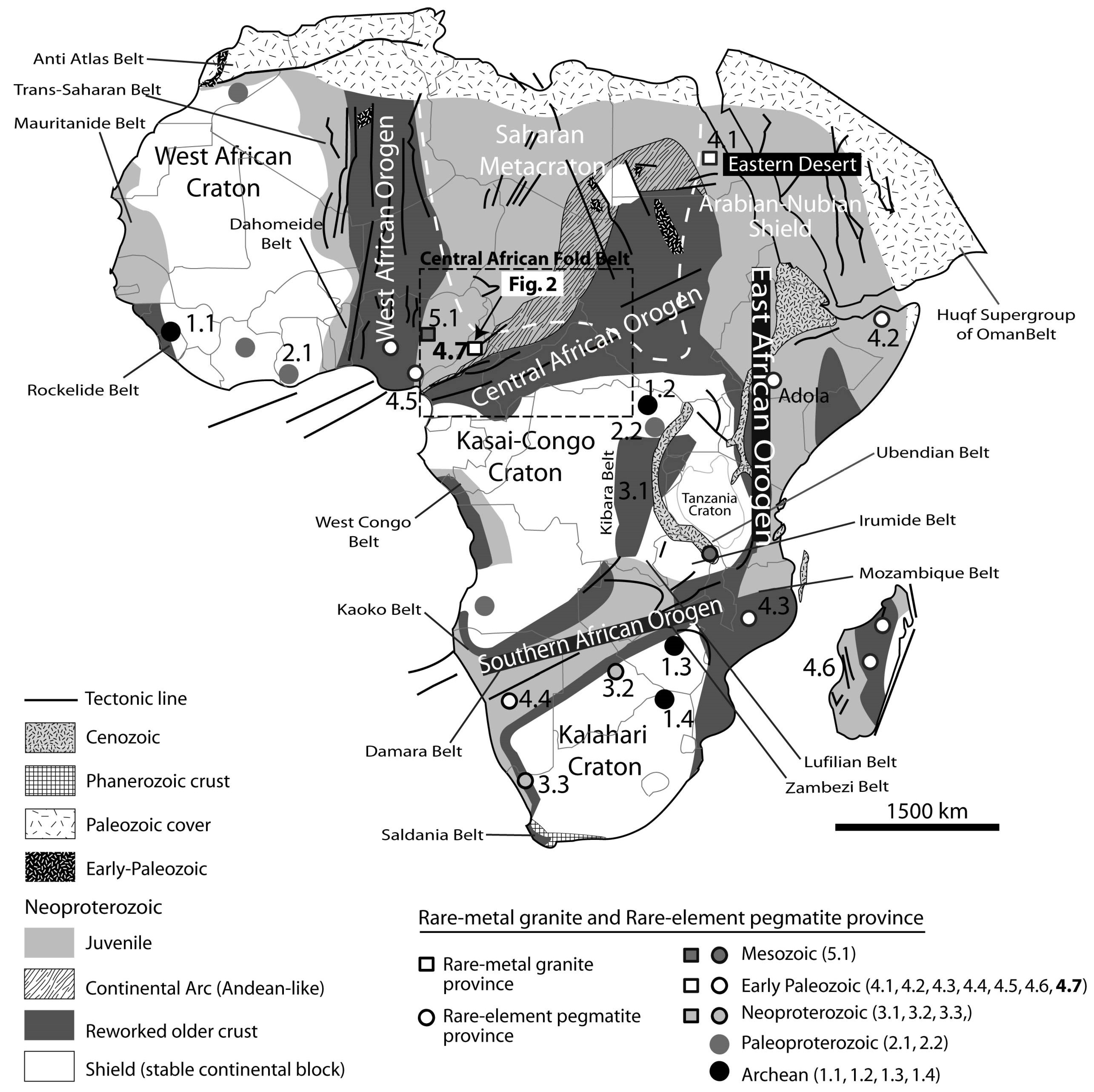

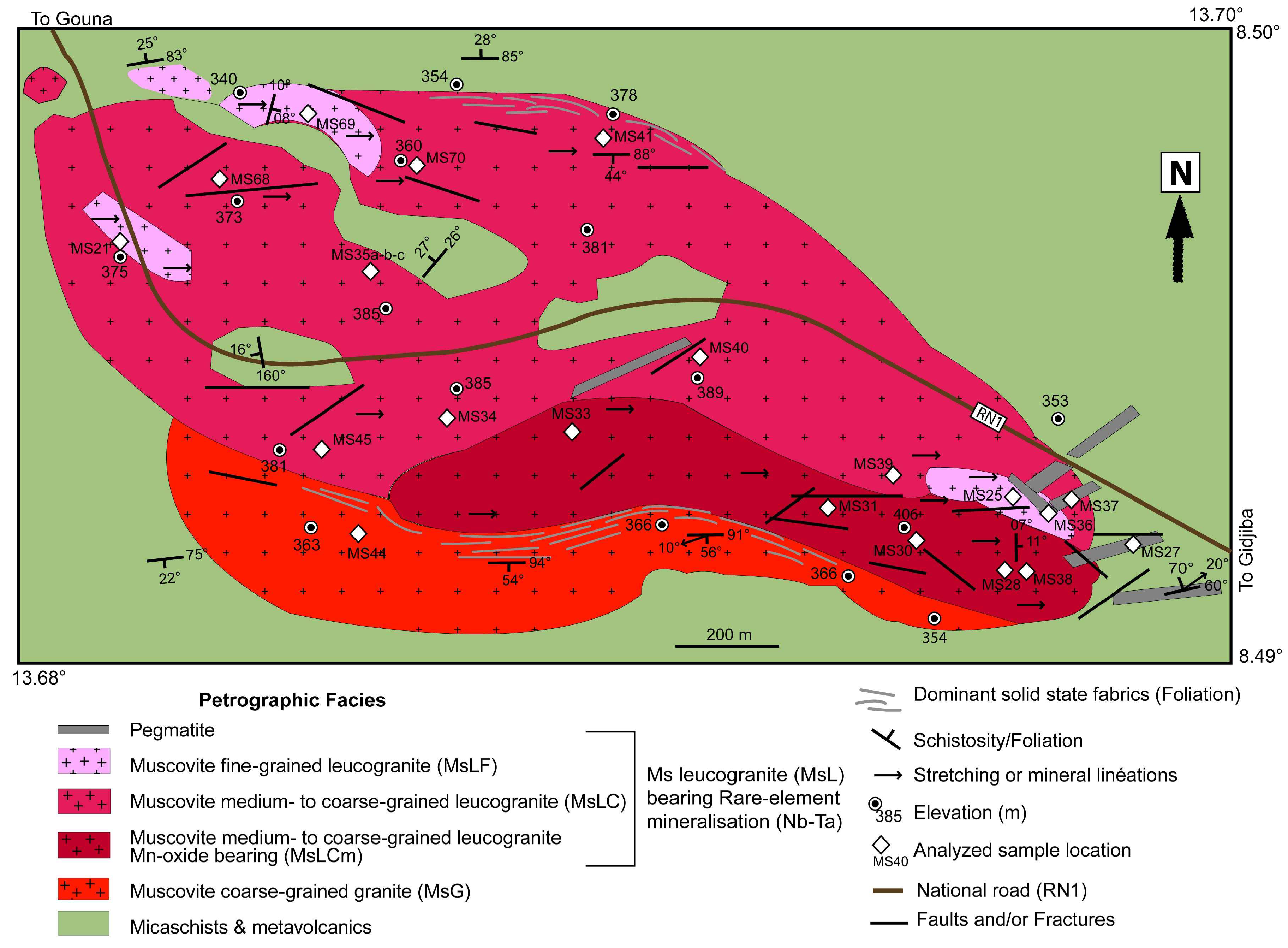

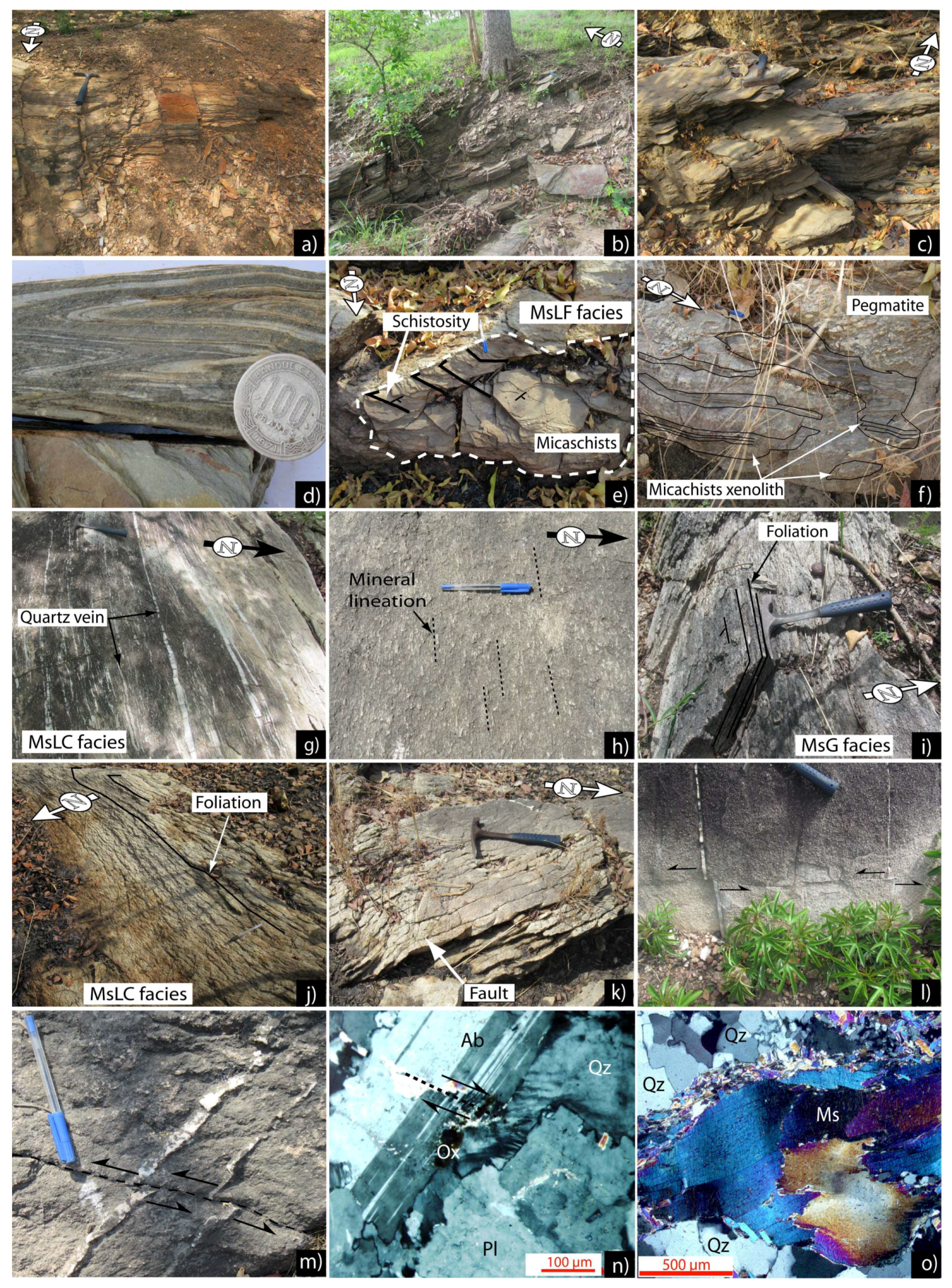
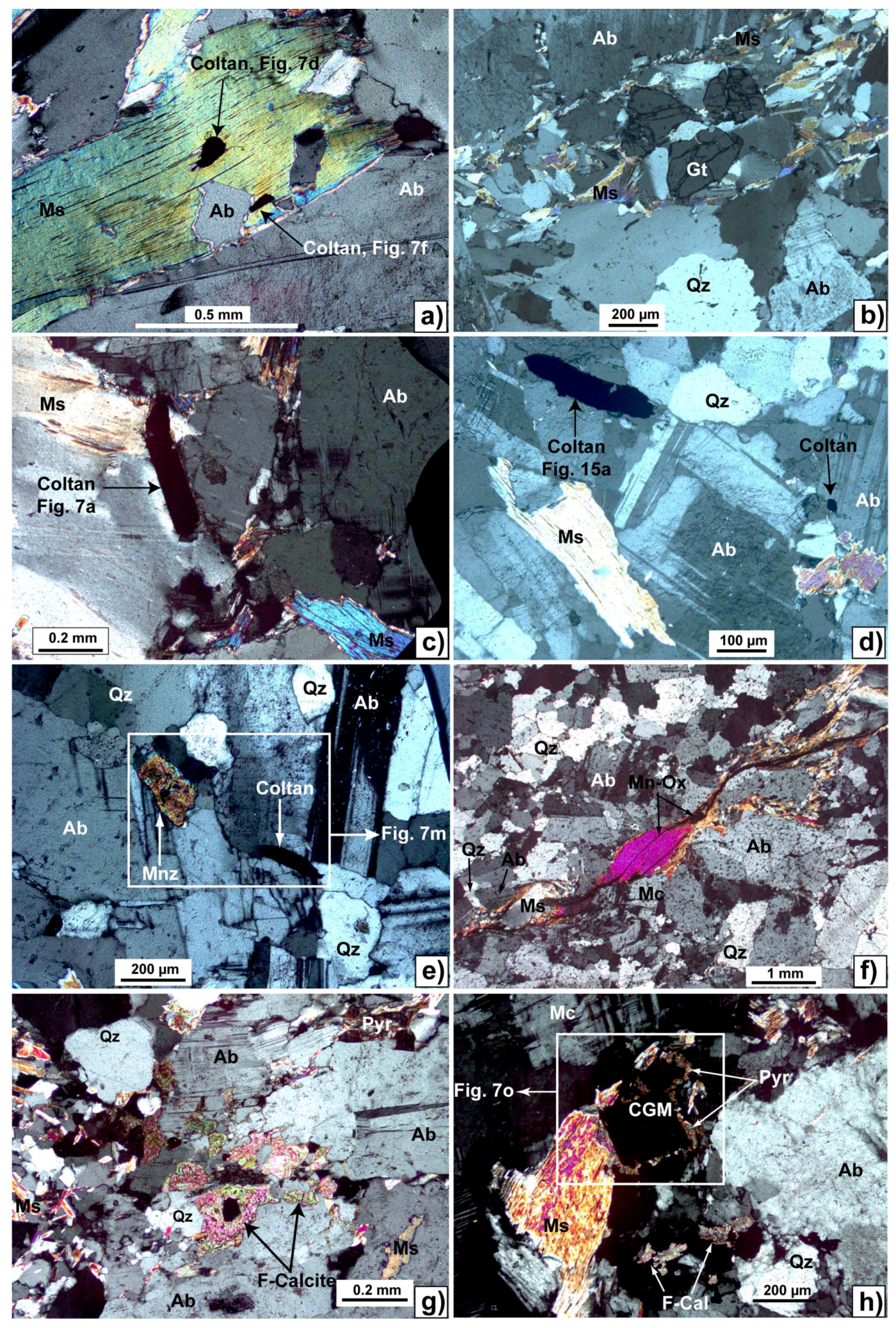
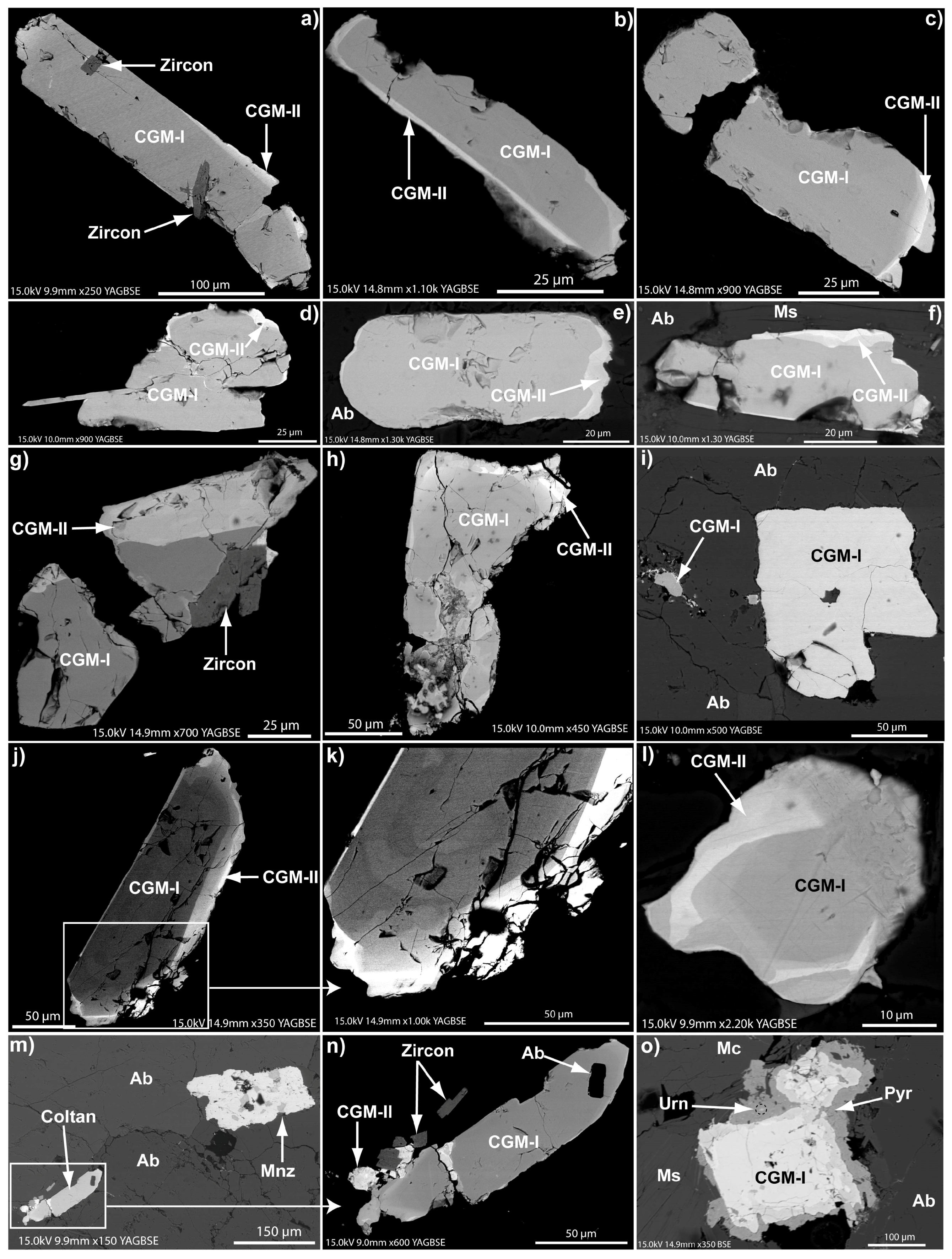
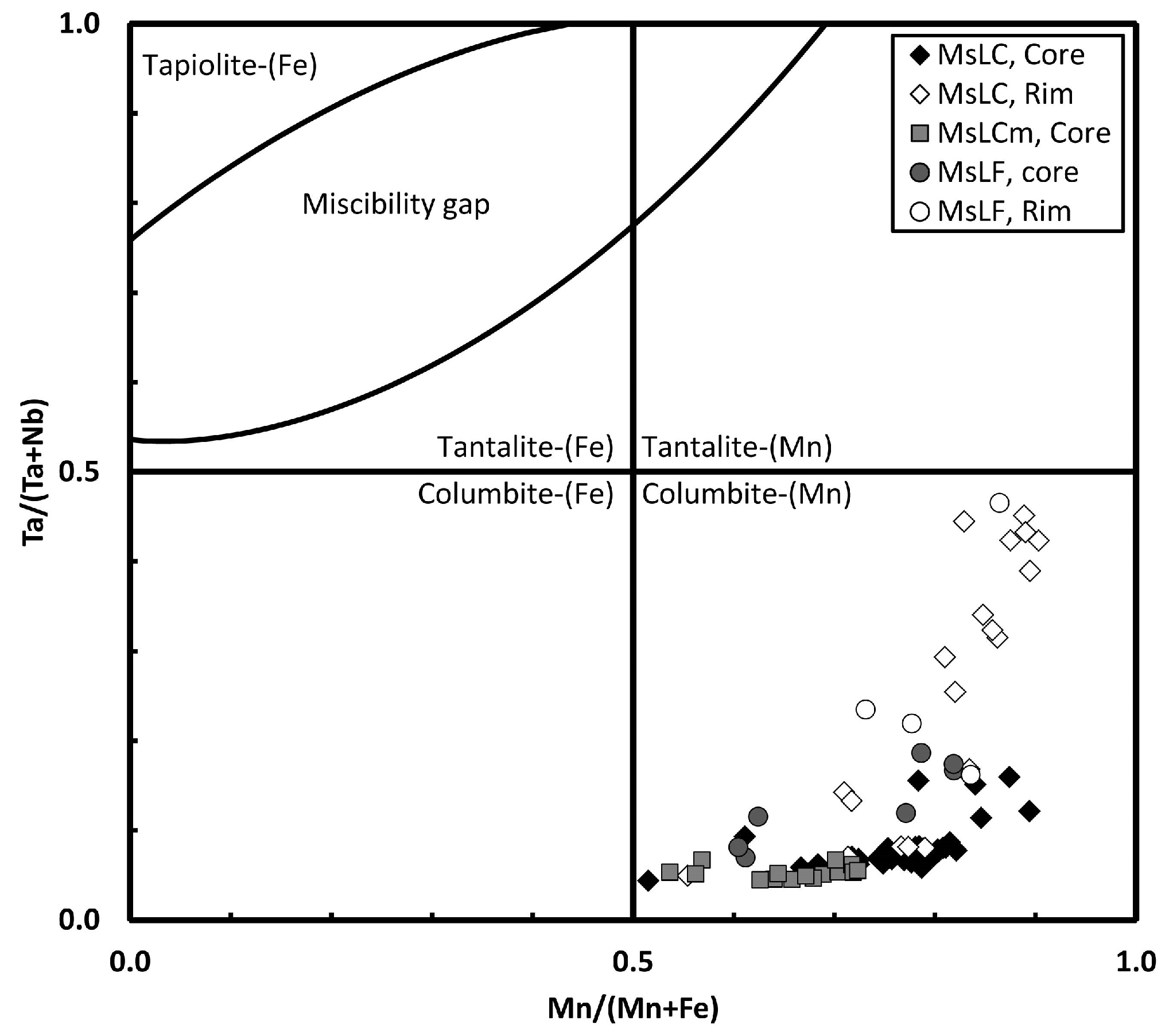

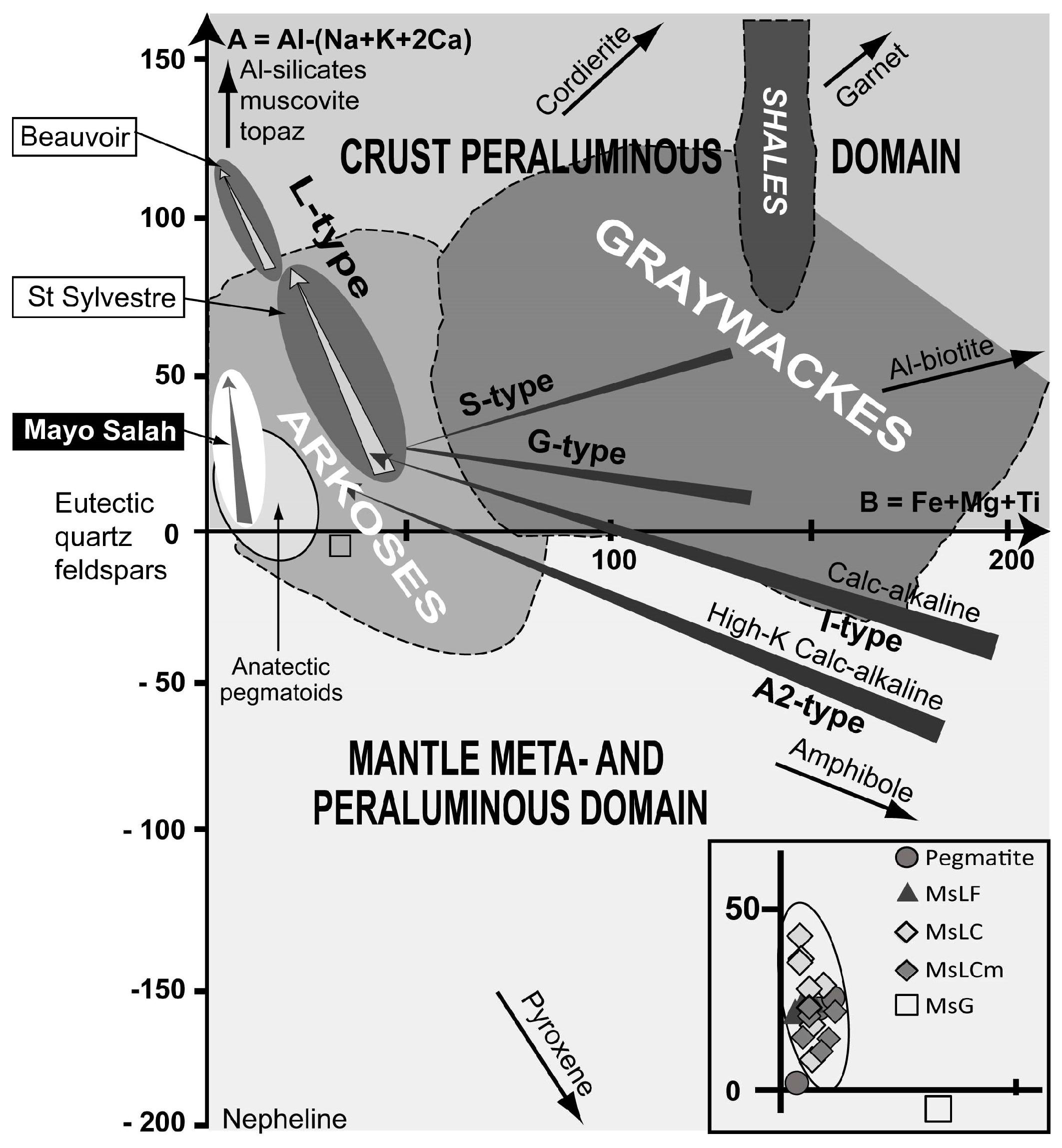
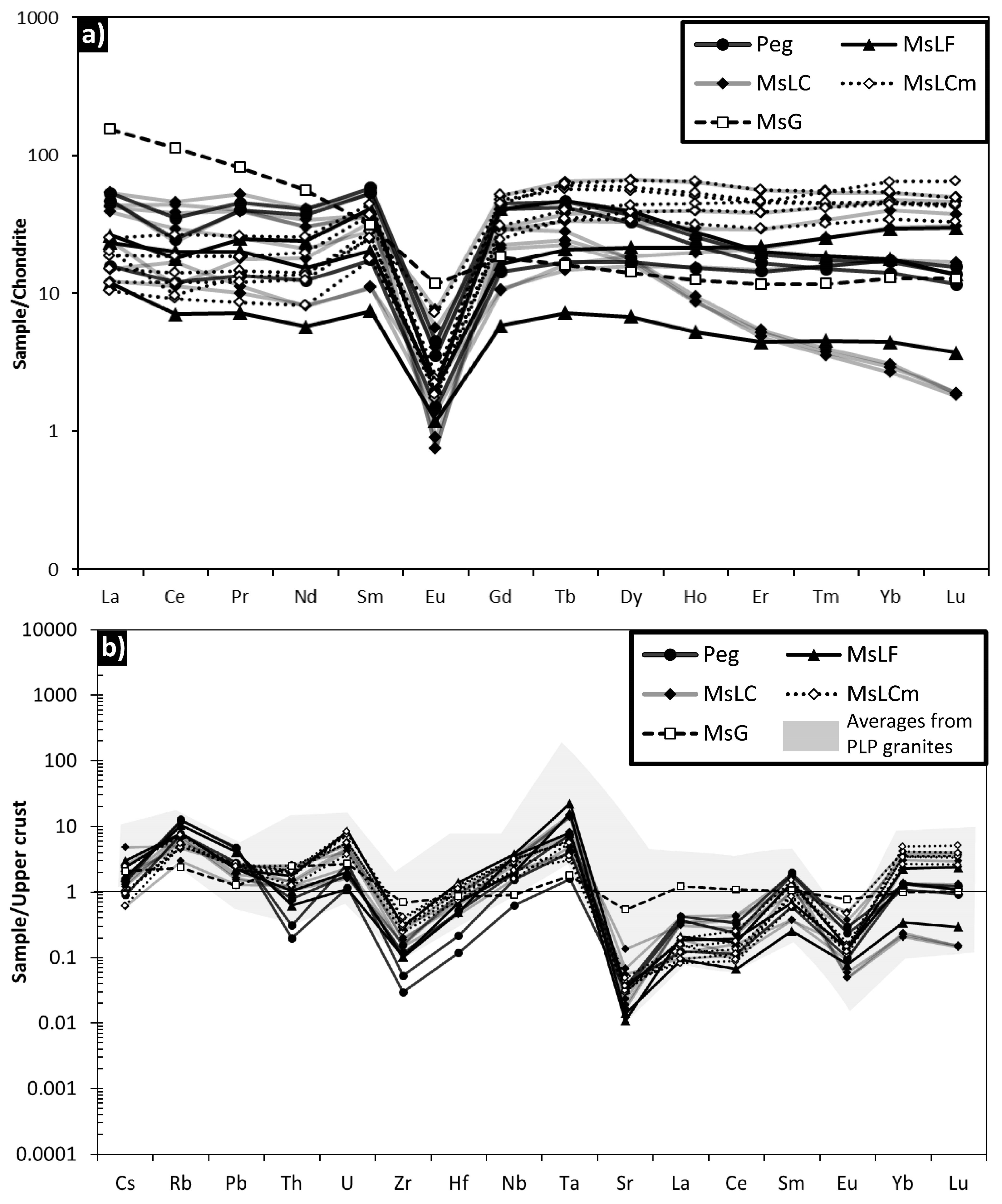
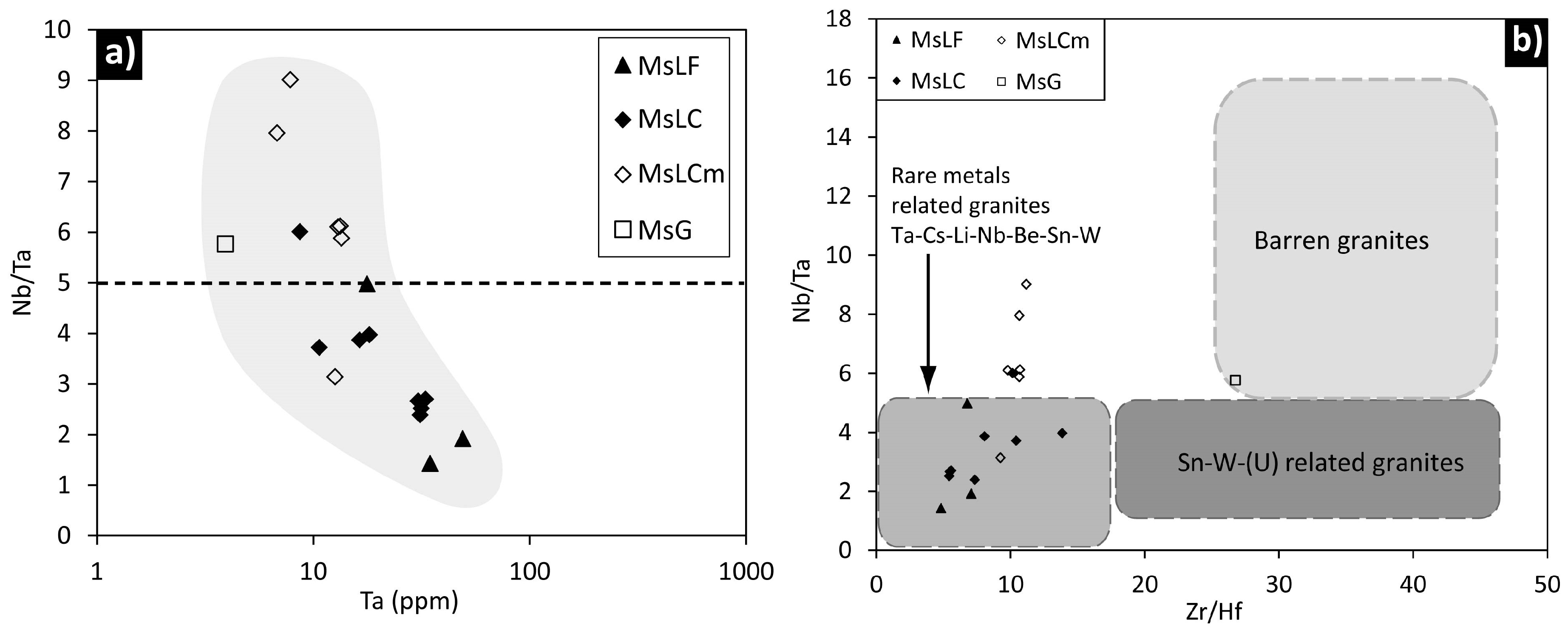

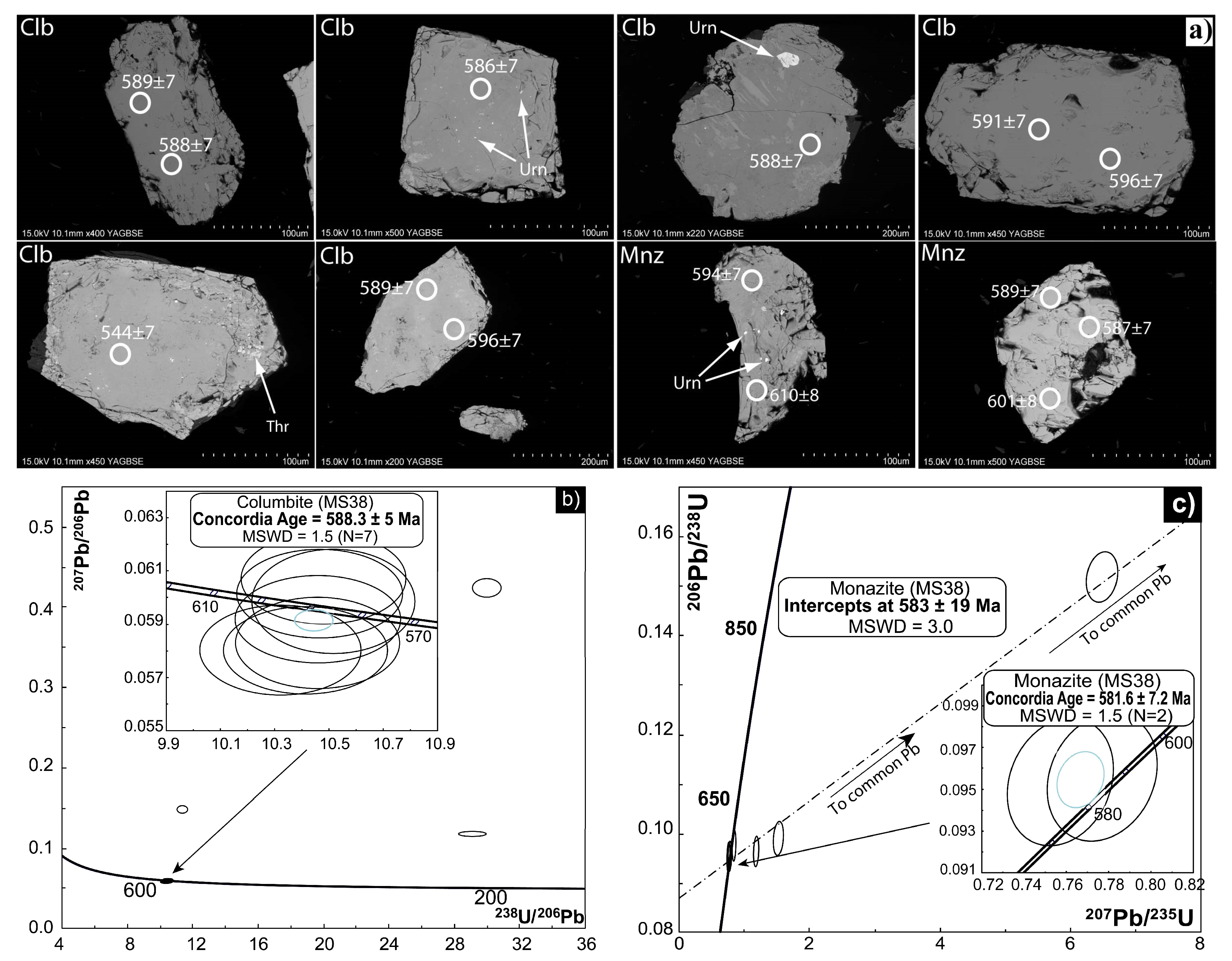
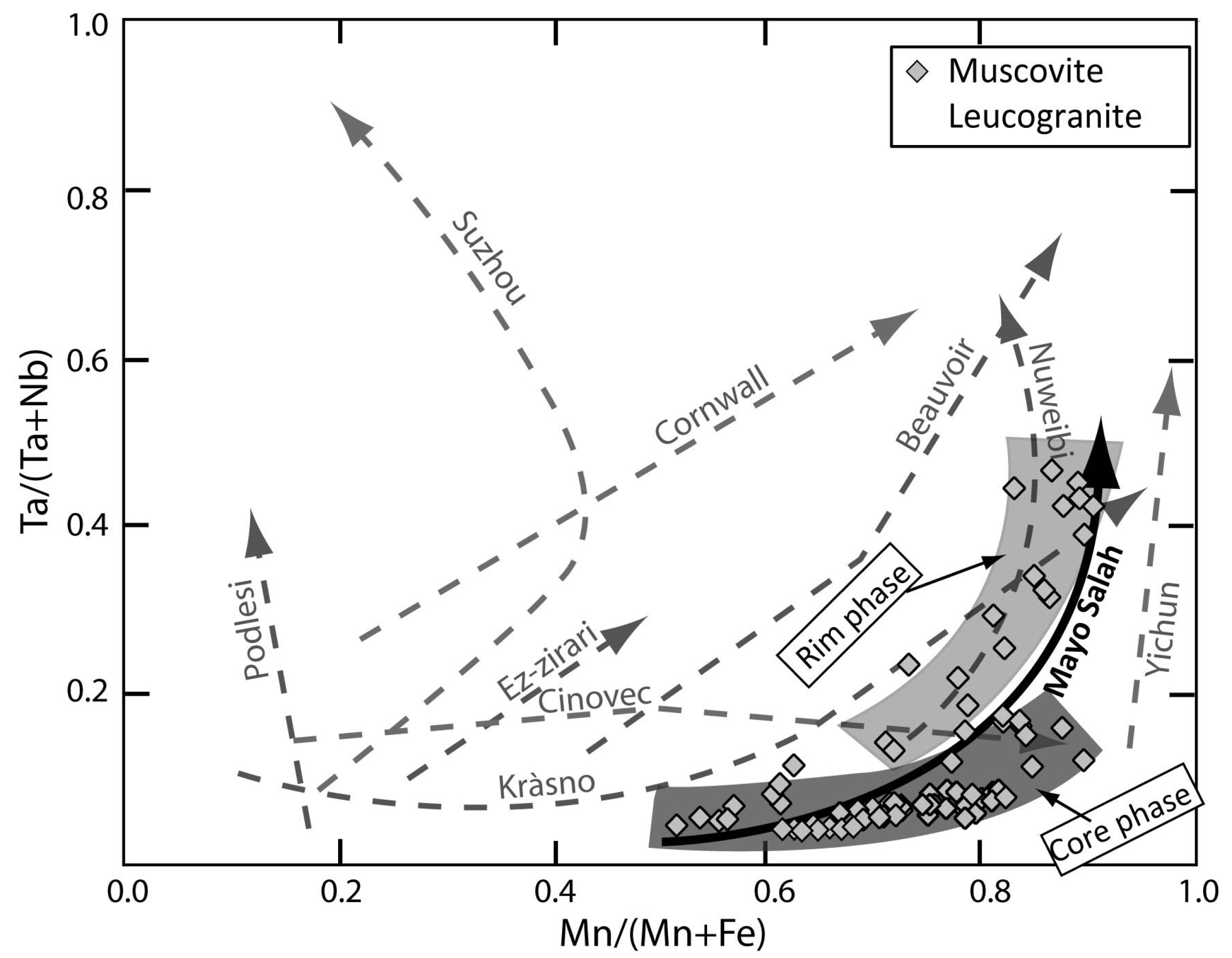

| Petrography (Facies) | Subgroup | Common Minerals | Minor Minerals | Rare Minerals |
|---|---|---|---|---|
| Muscovite granite (MsG) | - | Quartz Muscovite Plagioclase Orthose | Microcline Zircon Titanite Fe-Oxide | Biotite Epidote Myrmekyte Garnet Allanite |
| Muscovite Leucogranite (MsL) | MsLC (Porphyric medium- to coarse-grained muscovite leucogranite) | Quartz Muscovite Plagioclase Microcline | Nb-Ta oxide Garnet Fluorite Mn-oxide | Cassiterite Wolframite Pyrochlore Zircon Fe-oxide Monazite |
| MsLCm (Porphyric medium- to coarse-grained muscovite leucogranite, manganese oxide-bearing) | Quartz Muscovite Plagioclase Calcite Mn-oxide Microcline | Pyrochlore Garnet Fluorite F-calcite Fe-oxide | Rutile Nb-Ta oxide Wolframite Cassiterite Zircon Monazite | |
| MsLF (Microgranular fine-grained muscovite leucogranite) | Quartz Muscovite Plagioclase Microcline | Nb-Ta oxide Garnet | Epidote Mn-oxide Fluorite | |
| Peg (Pegmatite) | Quartz Muscovite Plagioclase Microcline Mn-oxide | Garnet Fe-oxide | Nb-Ta oxide Zircon |
| Rock Types | Ms-Leucogranite (MsL) | Ms-Granite | |||||||||||||||||||
|---|---|---|---|---|---|---|---|---|---|---|---|---|---|---|---|---|---|---|---|---|---|
| Facies | Pegmatite | MsLF | MsLC | MsLCm | MsG | ||||||||||||||||
| Sample | MS37 | MS27 | MS37a | MS21 | MS25a | MS36a | MS34 | MS35a | MS35b | MS35C | MS39 | MS40 | MS41 | MS45 | MS28b | MS28c | MS30 | MS31 | MS33a | MS38 | MS44 |
| SiO2 | 70.25 | 73.60 | 70.78 | 73.11 | 74.96 | 75.75 | 75.11 | 79.39 | 77.04 | 77.39 | 74.69 | 74.02 | 74.29 | 76.42 | 74.60 | 73.03 | 74.29 | 75.24 | 73.08 | 74.29 | 72.10 |
| TiO2 | b.d. | b.d. | b.d. | 0.03 | b.d. | b.d. | 0.03 | b.d. | b.d. | b.d. | 0.02 | b.d. | 0.02 | 0.02 | 0.03 | 0.04 | b.d. | 0.04 | b.d. | 0.02 | 0.24 |
| Al2O3 | 16.11 | 14.51 | 15.64 | 15.33 | 14.44 | 12.47 | 14.25 | 12.48 | 14.02 | 13.66 | 14.32 | 14.56 | 14.35 | 13.99 | 14.52 | 14.71 | 14.18 | 13.65 | 15.28 | 14.35 | 13.95 |
| Fe2O3t | 0.64 | 0.89 | 0.26 | 0.44 | 0.41 | 0.24 | 0.64 | 0.32 | 0.34 | 0.32 | 0.51 | 0.48 | 0.42 | 0.47 | 0.77 | 0.88 | 0.47 | 0.64 | 0.37 | 0.42 | 1.62 |
| MnO | 0.16 | 0.06 | 0.10 | 0.12 | 0.16 | 0.04 | 0.07 | 0.08 | 0.11 | 0.14 | 0.08 | 0.16 | 0.09 | 0.06 | 0.13 | 0.13 | 0.09 | 0.09 | 0.17 | 0.09 | 0.04 |
| MgO | b.d. | b.d. | b.d. | 0.02 | b.d. | b.d. | 0.03 | b.d. | b.d. | b.d. | b.d. | b.d. | 0.02 | 0.02 | b.d. | b.d. | b.d. | b.d. | b.d. | 0.02 | 0.40 |
| CaO | 0.60 | 1.09 | 0.73 | 0.80 | 0.72 | b.d. | 0.48 | 0.42 | 0.37 | 0.39 | 0.65 | 0.78 | 0.83 | 0.77 | 1.30 | 1.35 | 0.85 | 0.88 | 0.87 | 0.83 | 1.75 |
| Na2O | 2.26 | 3.06 | 2.12 | 4.91 | 4.82 | 1.78 | 4.71 | 4.86 | 4.97 | 4.90 | 4.77 | 4.72 | 4.57 | 4.94 | 4.03 | 3.87 | 4.29 | 4.17 | 5.54 | 4.57 | 3.96 |
| K2O | 9.37 | 5.73 | 9.89 | 4.18 | 3.60 | 7.79 | 3.86 | 1.47 | 3.08 | 2.87 | 4.05 | 3.66 | 3.86 | 3.72 | 4.43 | 4.43 | 4.19 | 4.30 | 3.56 | 3.86 | 4.15 |
| P2O5 | b.d. | b.d. | b.d. | b.d. | b.d. | b.d. | b.d. | b.d. | b.d. | b.d. | b.d. | b.d. | b.d. | b.d. | b.d. | b.d. | b.d. | b.d. | b.d. | b.d. | 0.06 |
| LOI | 0.92 | 1.26 | 0.74 | 0.87 | 1.04 | 0.43 | 0.94 | 0.88 | 0.88 | 0.82 | 0.81 | 1.35 | 1.16 | 0.58 | 1.45 | 1.45 | 1.06 | 1.15 | 1.02 | 1.16 | 1.69 |
| Total | 100.31 | 100.19 | 100.26 | 99.81 | 100.14 | 98.50 | 100.10 | 99.89 | 100.81 | 100.49 | 99.89 | 99.72 | 99.61 | 100.98 | 101.25 | 99.88 | 99.43 | 100.16 | 99.89 | 99.61 | 99.95 |
| Ba | 84 | 24 | 38 | 11 | 2.1 | 3.0 | 145 | 11 | 5.6 | 31 | 30 | 18 | 14 | 14 | 21 | 20 | 17 | 11 | 58 | 25 | 452 |
| Be | 2 | 2 | 1 | 4 | 6 | 3 | 10 | 4 | 4 | 4 | 6 | 4 | 4 | 9 | 7 | 6 | 5 | 4 | 6 | 6 | 6 |
| Bi | 2 | 0.20 | 1.5 | 0.50 | 5.4 | 0.76 | 0.75 | 8.4 | 7.2 | 3.4 | 0.92 | 2.1 | 0.29 | 0.13 | 0.94 | 0.97 | 5.8 | 0.35 | 1.3 | 1.2 | 0.46 |
| Cs | 5.8 | 3.3 | 5.2 | 8.9 | 11 | 6.3 | 7.4 | 2.2 | 4.8 | 4.5 | 5.8 | 9.7 | 5.9 | 18 | 8.8 | 9.1 | 2.3 | 3.9 | 3.6 | 3.5 | 7.7 |
| Cu | 19 | b.d. | b.d. | b.d. | b.d. | 15 | b.d. | b.d. | b.d. | b.d. | 11 | b.d. | b.d. | b.d. | 5.7 | 17 | b.d. | b.d. | 6.5 | b.d. | 6.0 |
| Ga | 46 | 48 | 36 | 47 | 48 | 35 | 31 | 45 | 50 | 48 | 36 | 47 | 41 | 32 | 48 | 50 | 40 | 34 | 35 | 44 | 24 |
| Ge | 3.8 | 4.0 | 3.7 | 3.7 | 4.3 | 4.9 | 3.0 | 4.0 | 4.4 | 4.2 | 3.5 | 4.3 | 4.0 | 3.2 | 3.4 | 3.5 | 3.1 | 3.0 | 3.4 | 3.8 | 2.1 |
| Hf | 1.3 | 3.0 | 0.68 | 8.1 | 2.9 | 4.1 | 4.2 | 5.2 | 5.5 | 5.5 | 3.7 | 4.4 | 6.5 | 2.6 | 6.9 | 7.4 | 4.3 | 4.9 | 5.8 | 6.6 | 5.0 |
| Nb | 38 | 49 | 16 | 94 | 88 | 50 | 72 | 89 | 81 | 79 | 52 | 63 | 74 | 40 | 79 | 82 | 54 | 71 | 79 | 40 | 23 |
| Pb | 92 | 56 | 95 | 44 | 44 | 81 | 54 | 25 | 33 | 31 | 56 | 50 | 37 | 49 | 50 | 48 | 48 | 53 | 55 | 50 | 25 |
| Rb | 1415 | 868 | 1367 | 896 | 892 | 1182 | 509 | 333 | 792 | 732 | 635 | 844 | 867 | 567 | 810 | 835 | 573 | 552 | 543 | 623 | 263 |
| Sc | 4.9 | 11 | 2.2 | 4.4 | 2.8 | 1.3 | 3.0 | b.d. | b.d. | b.d. | 4.0 | 6.8 | 5.1 | 4.1 | 28 | 29 | 11 | 4.2 | 7.7 | 5.1 | 3.3 |
| Sn | 79 | 145 | 34 | 85 | 55 | 148 | 28 | 46 | 71 | 62 | 105 | 70 | 72 | 77 | 143 | 161 | 83 | 53 | 43 | 52 | 7.6 |
| Sr | 12 | 14 | 11 | 12 | 3.8 | 4.9 | 47 | 24 | 6.6 | 8.1 | 12 | 5.8 | 13 | 19 | 11 | 10 | 11 | 15 | 17 | 13 | 188 |
| Ta | 9.0 | 17 | 3.5 | 49 | 18 | 35 | 18 | 33 | 30 | 32 | 8.7 | 16 | 31 | 11 | 13 | 13 | 6.8 | 7.8 | 13 | 13 | 3.9 |
| Th | 3.3 | 8.4 | 2.1 | 19 | 11 | 6.6 | 22 | 13 | 11 | 13 | 15 | 25 | 16 | 28 | 19 | 21 | 13 | 22 | 23 | 27 | 26 |
| U | 7.6 | 5.1 | 3.3 | 24 | 5.7 | 3.1 | 16 | 6.5 | 4.5 | 4.7 | 12 | 15 | 13 | 12 | 21 | 22 | 11 | 16 | 24 | 16 | 7.6 |
| V | 0.94 | 0.84 | 1.6 | 0.95 | 0.74 | b.d. | 2.3 | b.d. | b.d. | b.d. | b.d. | b.d. | b.d. | 0.74 | b.d. | 0.74 | 0.81 | 2.3 | 1.1 | b.d. | 13 |
| W | 2.4 | 4.0 | 2.4 | 3.3 | 1.4 | 0.91 | 1.1 | 2.0 | 1.7 | 1.6 | 1.1 | 1.5 | 2.9 | 0.7 | 2.2 | 2.3 | 6.4 | 4.0 | 2.4 | 2.1 | 28 |
| Y | 71 | 57 | 65 | 48 | 72 | 9.6 | 97 | 17 | 18 | 17 | 157 | 77 | 44 | 32 | 220 | 221 | 115 | 90 | 123 | 172 | 21 |
| Zn | 135 | 145 | 78 | 83 | 171 | 76 | 51 | 107 | 165 | 174 | 77 | 160 | 58 | 58 | 159 | 178 | 98 | 57 | 72 | 77 | 62 |
| Zr | 10 | 22 | 5.6 | 57 | 19 | 20 | 58 | 29 | 30 | 30 | 38 | 35 | 48 | 28 | 73 | 79 | 46 | 54 | 57 | 61 | 132 |
| La | 13 | 3.7 | 11 | 5.5 | 6.2 | 2.8 | 9.2 | 13 | 10.0 | 10 | 5.7 | 11 | 3.5 | 2.9 | 4.4 | 6.0 | 3.6 | 2.5 | 4.8 | 2.8 | 37 |
| Ce | 21 | 7.3 | 15 | 12 | 11 | 4.3 | 18 | 28 | 23 | 27 | 7.0 | 14 | 10 | 6.8 | 11 | 16 | 8.6 | 5.6 | 5.9 | 7.3 | 69 |
| Pr | 4.3 | 1.3 | 3.8 | 1.9 | 2.4 | 0.68 | 2.4 | 5.0 | 3.7 | 3.8 | 1.7 | 3.8 | 1.1 | 0.95 | 1.8 | 2.5 | 1.4 | 0.82 | 1.3 | 1.1 | 7.7 |
| Nd | 19 | 5.8 | 17 | 7.1 | 11 | 2.7 | 9.8 | 19 | 14 | 14 | 8.4 | 16 | 3.8 | 3.8 | 9.2 | 12 | 6.6 | 3.8 | 6.3 | 5.9 | 26 |
| Sm | 8.8 | 2.7 | 8.2 | 3.1 | 6.3 | 1.1 | 4.3 | 8.0 | 5.7 | 5.6 | 5.0 | 5.7 | 1.7 | 1.7 | 5.7 | 6.8 | 3.8 | 2.7 | 4.3 | 3.9 | 4.7 |
| Eu | 0.26 | 0.09 | 0.21 | 0.12 | 0.12 | 0.07 | 0.24 | 0.04 | 0.04 | 0.05 | 0.44 | 0.33 | 0.08 | 0.13 | 0.13 | 0.14 | 0.10 | 0.13 | 0.42 | 0.11 | 0.68 |
| Gd | 9.1 | 2.9 | 8.4 | 3.3 | 8.4 | 1.2 | 6.1 | 6.0 | 4.6 | 4.3 | 10 | 5.9 | 2.1 | 2.2 | 9.8 | 11 | 5.8 | 5.1 | 9.2 | 6.4 | 3.7 |
| Tb | 1.7 | 0.63 | 1.6 | 0.77 | 1.8 | 0.27 | 1.4 | 1.0 | 0.91 | 0.84 | 2.4 | 1.2 | 0.61 | 0.55 | 2.1 | 2.2 | 1.3 | 1.3 | 2.3 | 1.5 | 0.60 |
| Dy | 9.4 | 4.3 | 8.2 | 5.5 | 9.9 | 1.7 | 10 | 4.5 | 4.5 | 4.2 | 17 | 8.3 | 4.7 | 4.0 | 14 | 15 | 8.7 | 9.9 | 17 | 11 | 3.6 |
| Ho | 1.4 | 0.86 | 1.3 | 1.2 | 1.6 | 0.30 | 2.2 | 0.49 | 0.54 | 0.49 | 3.6 | 1.7 | 1.1 | 0.88 | 2.9 | 3.0 | 1.8 | 2.3 | 3.7 | 2.5 | 0.71 |
| Er | 3.1 | 2.4 | 2.7 | 3.6 | 3.3 | 0.73 | 6.3 | 0.80 | 0.90 | 0.86 | 9.2 | 4.8 | 3.5 | 2.4 | 7.5 | 7.8 | 4.9 | 6.4 | 9.3 | 7.7 | 1.9 |
| Tm | 0.44 | 0.40 | 0.38 | 0.64 | 0.47 | 0.12 | 1.1 | 0.09 | 0.10 | 0.10 | 1.4 | 0.87 | 0.64 | 0.40 | 1.1 | 1.2 | 0.81 | 1.1 | 1.4 | 1.4 | 0.30 |
| Yb | 2.9 | 2.9 | 2.4 | 5.0 | 3.0 | 0.75 | 8.1 | 0.45 | 0.52 | 0.49 | 9.0 | 6.7 | 5.1 | 2.9 | 7.6 | 7.9 | 5.8 | 7.6 | 9.3 | 11 | 2.2 |
| Lu | 0.35 | 0.40 | 0.29 | 0.76 | 0.35 | 0.09 | 1.2 | 0.05 | 0.05 | 0.05 | 1.3 | 0.94 | 0.78 | 0.42 | 1.1 | 1.1 | 0.84 | 1.1 | 1.3 | 1.6 | 0.32 |
| NK | 11.63 | 8.79 | 12.01 | 9.09 | 8.42 | 9.57 | 8.57 | 6.33 | 8.06 | 7.78 | 8.82 | 8.38 | 8.43 | 8.67 | 8.46 | 8.30 | 8.48 | 8.46 | 9.09 | 8.43 | 8.11 |
| A* | 22.12 | 24.93 | 1.86 | 24.41 | 25.28 | 21.33 | 28.43 | 41.81 | 35.67 | 34.70 | 17.56 | 27.43 | 22.40 | 8.18 | 13.87 | 21.28 | 20.06 | 10.54 | 14.25 | 22.40 | -5.07 |
| B* | 7.98 | 11.11 | 3.30 | 6.42 | 5.09 | 2.94 | 9.01 | 3.97 | 4.26 | 3.97 | 6.62 | 5.96 | 5.96 | 6.58 | 10.04 | 11.41 | 5.93 | 8.51 | 4.58 | 5.96 | 33.24 |
| A/CNK | 1.08 | 1.10 | 1.01 | 1.09 | 1.10 | 1.10 | 1.11 | 1.21 | 1.15 | 1.15 | 1.07 | 1.11 | 1.09 | 1.03 | 1.05 | 1.08 | 1.08 | 1.04 | 1.05 | 1.09 | 0.98 |
| Nb/Ta | 4.2 | 2.9 | 4.5 | 1.9 | 5.0 | 1.4 | 4.0 | 2.7 | 2.7 | 2.5 | 6.0 | 3.9 | 2.4 | 3.7 | 5.9 | 6.1 | 8.0 | 9.0 | 6.1 | 3.1 | 5.8 |
| Zr/Hf | 8.0 | 7.5 | 8.2 | 7.1 | 6.8 | 4.8 | 14 | 5.6 | 5.5 | 5.4 | 10 | 8.1 | 7.3 | 10 | 11 | 11 | 11 | 11 | 9.8 | 9.2 | 27 |
| K/Rb | 55 | 55 | 60 | 39 | 33 | 55 | 63 | 37 | 32 | 33 | 53 | 36 | 37 | 54 | 45 | 44 | 61 | 65 | 54 | 51 | 131 |
| Σ REE | 95 | 36 | 81 | 51 | 66 | 17 | 80 | 86 | 69 | 72 | 82 | 82 | 39 | 30 | 79 | 92 | 54 | 50 | 76 | 64 | 158 |
| Σ LREE | 66 | 21 | 56 | 30 | 37 | 12 | 44 | 73 | 57 | 61 | 28 | 51 | 21 | 16 | 33 | 44 | 24 | 16 | 23 | 21 | 145 |
| Σ HREE | 28 | 15 | 25 | 21 | 29 | 5 | 36 | 13 | 12 | 11 | 54 | 30 | 19 | 14 | 46 | 49 | 30 | 35 | 53 | 43 | 13 |
| (La/Yb)N | 3.1 | 0.91 | 3.3 | 0.79 | 1.5 | 2.7 | 0.82 | 20 | 14 | 15 | 0.45 | 1.2 | 0.50 | 0.71 | 0.42 | 0.54 | 0.44 | 0.23 | 0.37 | 0.19 | 12 |
| (La/Sm)N | 0.92 | 0.90 | 0.87 | 1.1 | 0.63 | 1.6 | 1.4 | 1.0 | 1.1 | 1.2 | 0.73 | 1.3 | 1.3 | 1.1 | 0.50 | 0.57 | 0.60 | 0.59 | 0.71 | 0.47 | 5.0 |
| (Gd/Yb)N | 2.6 | 0.82 | 2.9 | 0.56 | 2.3 | 1.3 | 0.63 | 11 | 7.3 | 7.2 | 0.96 | 0.72 | 0.35 | 0.62 | 1.1 | 1.1 | 0.82 | 0.55 | 0.82 | 0.48 | 1.4 |
| Eu/Eu* | 0.09 | 0.10 | 0.08 | 0.11 | 0.05 | 0.18 | 0.14 | 0.02 | 0.03 | 0.03 | 0.18 | 0.17 | 0.13 | 0.20 | 0.05 | 0.05 | 0.07 | 0.11 | 0.20 | 0.07 | 0.49 |
| Sample | Spot Number | Concentrations (ppm) | Isotope Ratios | Ages (Ma) | |||||||
|---|---|---|---|---|---|---|---|---|---|---|---|
| Pb | U | Th | Th/U | 207Pb/206Pb | Err (%) | 238U/206Pb | Err (%) | 206Pb/238U | Err (Abs.) | ||
| MS35c | 1 | 603 | 6537 | 310 | 0.05 | 0.0596 | 1.02 | 10.057 | 1.17 | 611 | 7 |
| 2 | 374 | 4046 | 270 | 0.07 | 0.0629 | 1.03 | 10.209 | 1.16 | 602 | 7 | |
| 3 | 419 | 4610 | 198 | 0.04 | 0.0592 | 1.03 | 10.195 | 1.16 | 603 | 7 | |
| 4 | 195 | 2118 | 92 | 0.04 | 0.0604 | 1.04 | 10.108 | 1.16 | 608 | 7 | |
| 5 | 538 | 2725 | 455 | 0.17 | 0.2169 | 1.03 | 7.394 | 1.17 | 818 | 9 | |
| 6 | 84 | 1208 | 74 | 0.06 | 0.0684 | 1.07 | 13.868 | 1.16 | 449 | 5 | |
| 7 | 458 | 3516 | 280 | 0.08 | 0.1637 | 1.03 | 10.121 | 1.16 | 607 | 7 | |
| 8 | 275 | 2904 | 164 | 0.06 | 0.0682 | 1.04 | 10.141 | 1.17 | 606 | 7 | |
| 9 | 340 | 3684 | 170 | 0.05 | 0.0587 | 1.04 | 10.052 | 1.17 | 611 | 7 | |
| 10 | 398 | 4675 | 218 | 0.05 | 0.0913 | 1.04 | 12.277 | 1.17 | 505 | 6 | |
| 11 | 333 | 3600 | 180 | 0.05 | 0.0589 | 1.05 | 10.058 | 1.17 | 611 | 7 | |
| 12 | 345 | 3741 | 233 | 0.06 | 0.0586 | 1.04 | 10.099 | 1.16 | 609 | 7 | |
| 13 | 299 | 3452 | 188 | 0.05 | 0.0629 | 1.05 | 10.909 | 1.17 | 565 | 6 | |
| 14 | 300 | 3304 | 150 | 0.05 | 0.0587 | 1.06 | 10.217 | 1.16 | 602 | 7 | |
| 15 | 327 | 3578 | 165 | 0.05 | 0.0587 | 1.07 | 10.168 | 1.17 | 605 | 7 | |
| 16 | 293 | 3528 | 146 | 0.04 | 0.0634 | 1.07 | 11.378 | 1.16 | 543 | 6 | |
| 17 | 772 | 5098 | 583 | 0.11 | 0.1918 | 1.06 | 9.117 | 1.17 | 671 | 7 | |
| 18 | 253 | 2646 | 219 | 0.08 | 0.0649 | 1.06 | 10.045 | 1.17 | 612 | 7 | |
| 19 | 190 | 1743 | 94 | 0.05 | 0.0809 | 1.08 | 9.200 | 1.17 | 665 | 7 | |
| 20 | 181 | 1996 | 92 | 0.05 | 0.0599 | 1.08 | 10.253 | 1.17 | 600 | 7 | |
| 21 | 328 | 3591 | 184 | 0.05 | 0.0585 | 1.09 | 10.172 | 1.17 | 605 | 7 | |
| 22 | 189 | 2059 | 87 | 0.04 | 0.0613 | 1.09 | 10.206 | 1.16 | 603 | 7 | |
| 23 | 206 | 2273 | 80 | 0.04 | 0.0607 | 1.10 | 10.280 | 1.16 | 599 | 7 | |
| MS38 | 24 | 7228 | 175722 | 4077 | 0.02 | 0.1179 | 1.09 | 29.104 | 1.19 | 218 | 3 |
| 25 | 188 | 2121 | 95 | 0.04 | 0.0602 | 1.13 | 10.466 | 1.19 | 588 | 7 | |
| 26 | 7050 | 95173 | 27522 | 0.29 | 0.4241 | 1.11 | 29.985 | 1.20 | 212 | 2 | |
| 27 | 386 | 4299 | 318 | 0.07 | 0.0592 | 1.13 | 10.459 | 1.19 | 589 | 7 | |
| 28 | 403 | 4452 | 343 | 0.08 | 0.0607 | 1.15 | 10.480 | 1.18 | 588 | 7 | |
| 29 | 478 | 5295 | 376 | 0.07 | 0.0580 | 1.15 | 10.413 | 1.19 | 591 | 7 | |
| 30 | 466 | 5096 | 377 | 0.07 | 0.0580 | 1.19 | 10.321 | 1.18 | 596 | 7 | |
| 31 | 377 | 4162 | 295 | 0.07 | 0.0583 | 1.20 | 10.458 | 1.18 | 589 | 7 | |
| 32 | 706 | 6215 | 542 | 0.09 | 0.1484 | 1.30 | 11.361 | 1.17 | 544 | 6 | |
| 33 | 294 | 3190 | 193 | 0.06 | 0.0599 | 1.34 | 10.516 | 1.17 | 586 | 7 | |
| Sample | Spot Number | Concentrations (ppm) | Isotope Ratios | Ages (Ma) | |||||||
|---|---|---|---|---|---|---|---|---|---|---|---|
| Pb | U | Th | Th/U | 206Pb/238U | Err (1σ) | 207Pb/235U | Err (1σ) | 206Pb/238U | Err (1σ) | ||
| MS35c | 1 | 2240 | 2732 | 72,814 | 26.7 | 0.0969 | 0.001 | 0.859 | 0.011 | 596 | 8 |
| 2 | 1093 | 582 | 47,738 | 82.1 | 0.2374 | 0.003 | 12.519 | 0.162 | 1372 | 16 | |
| 3 | 923 | 542 | 32,103 | 59.2 | 0.0990 | 0.001 | 0.794 | 0.012 | 608 | 8 | |
| 4 | 1085 | 738 | 37,913 | 51.4 | 0.1572 | 0.002 | 6.395 | 0.083 | 941 | 12 | |
| 5 | 912 | 453 | 31,492 | 69.6 | 0.0977 | 0.001 | 0.788 | 0.012 | 600 | 8 | |
| 6 | 959 | 309 | 39,680 | 128.5 | 0.1942 | 0.003 | 9.273 | 0.126 | 1144 | 14 | |
| 7 | 1377 | 1632 | 58,942 | 36.1 | 0.1649 | 0.002 | 6.995 | 0.091 | 983 | 12 | |
| 8 | 1112 | 775 | 44,679 | 57.7 | 0.1687 | 0.002 | 7.300 | 0.097 | 1004. | 12 | |
| 9 | 1921 | 2716 | 74,383 | 27.4 | 0.1100 | 0.001 | 2.272 | 0.030 | 6726 | 8 | |
| 10 | 1786 | 1750 | 81,966 | 46.8 | 0.1525 | 0.002 | 6.049 | 0.080 | 914 | 11 | |
| 11 | 3711 | 5897 | 116,034 | 19.7 | 0.0984 | 0.001 | 1.036 | 0.014 | 605 | 8 | |
| 12 | 3665 | 5875 | 108,799 | 18.5 | 0.0959 | 0.001 | 0.947 | 0.013 | 590 | 7 | |
| MS38 | 13 | 1965 | 2600 | 61,206 | 23.5 | 0.0956 | 0.001 | 0.777 | 0.011 | 588 | 7 |
| 14 | 2453 | 4132 | 73,798 | 17.9 | 0.0954 | 0.001 | 0.757 | 0.010 | 587 | 7 | |
| 15 | 1612 | 1988 | 53,603 | 27.0 | 0.0977 | 0.001 | 0.842 | 0.012 | 600 | 8 | |
| 16 | 2344 | 2871 | 80,714 | 28.1 | 0.0965 | 0.001 | 1.181 | 0.016 | 594 | 7 | |
| 17 | 1758 | 815 | 71,159 | 87.3 | 0.0992 | 0.001 | 1.522 | 0.032 | 609 | 8 | |
| 18 | 817 | 182 | 28,466 | 156.4 | 0.1519 | 0.002 | 6.483 | 0.099 | 911 | 12 | |
© 2018 by the authors. Licensee MDPI, Basel, Switzerland. This article is an open access article distributed under the terms and conditions of the Creative Commons Attribution (CC BY) license (http://creativecommons.org/licenses/by/4.0/).
Share and Cite
Fosso Tchunte, P.M.; Tchameni, R.; André-Mayer, A.-S.; Dakoure, H.S.; Turlin, F.; Poujol, M.; Nomo, E.N.; Saha Fouotsa, A.N.; Rouer, O. Evidence for Nb-Ta Occurrences in the Syn-Tectonic Pan-African Mayo Salah Leucogranite (Northern Cameroon): Constraints from Nb-Ta Oxide Mineralogy, Geochemistry and U-Pb LA-ICP-MS Geochronology on Columbite and Monazite. Minerals 2018, 8, 188. https://doi.org/10.3390/min8050188
Fosso Tchunte PM, Tchameni R, André-Mayer A-S, Dakoure HS, Turlin F, Poujol M, Nomo EN, Saha Fouotsa AN, Rouer O. Evidence for Nb-Ta Occurrences in the Syn-Tectonic Pan-African Mayo Salah Leucogranite (Northern Cameroon): Constraints from Nb-Ta Oxide Mineralogy, Geochemistry and U-Pb LA-ICP-MS Geochronology on Columbite and Monazite. Minerals. 2018; 8(5):188. https://doi.org/10.3390/min8050188
Chicago/Turabian StyleFosso Tchunte, Periclex Martial, Rigobert Tchameni, Anne-Sylvie André-Mayer, Hilaire Somtebda Dakoure, François Turlin, Marc Poujol, Emmanuel Negue Nomo, Alliance Nicaise Saha Fouotsa, and Olivier Rouer. 2018. "Evidence for Nb-Ta Occurrences in the Syn-Tectonic Pan-African Mayo Salah Leucogranite (Northern Cameroon): Constraints from Nb-Ta Oxide Mineralogy, Geochemistry and U-Pb LA-ICP-MS Geochronology on Columbite and Monazite" Minerals 8, no. 5: 188. https://doi.org/10.3390/min8050188





